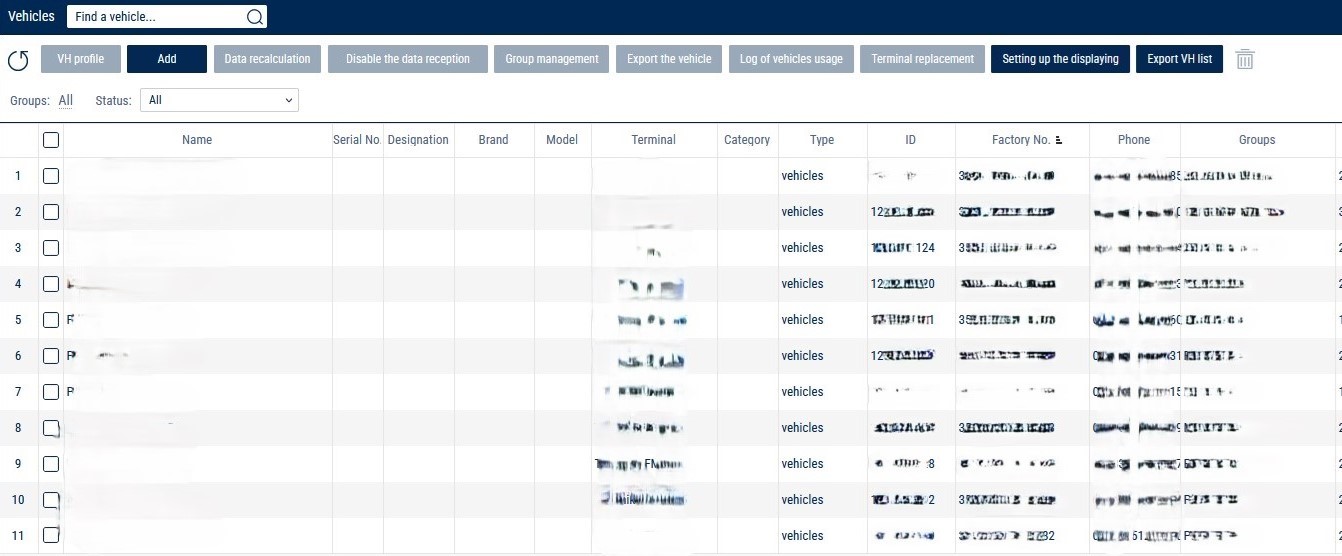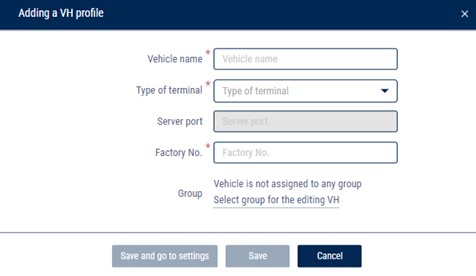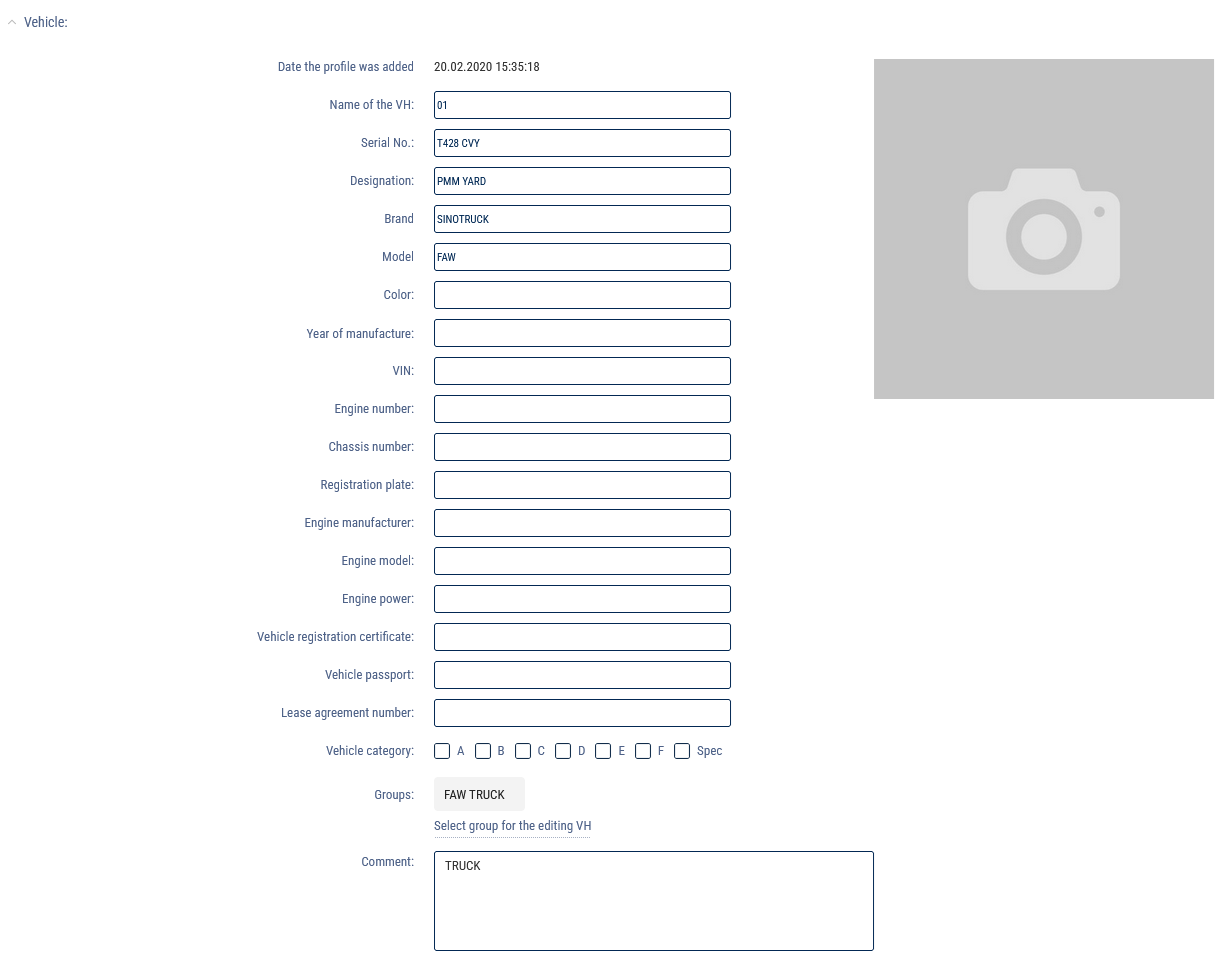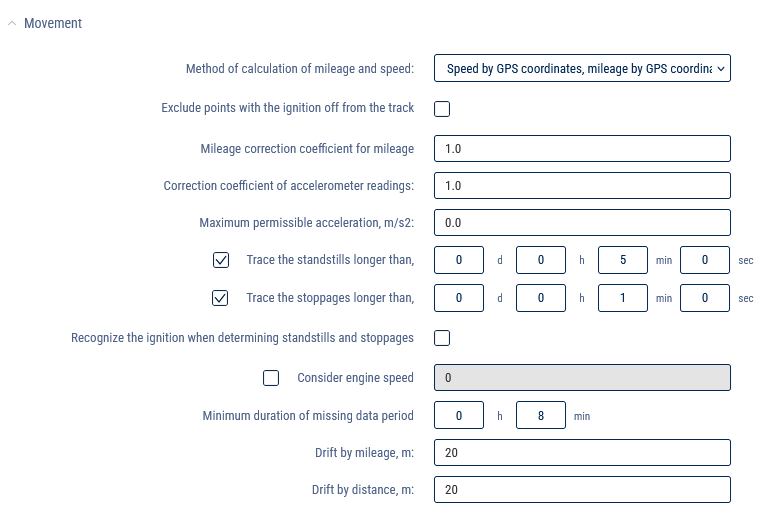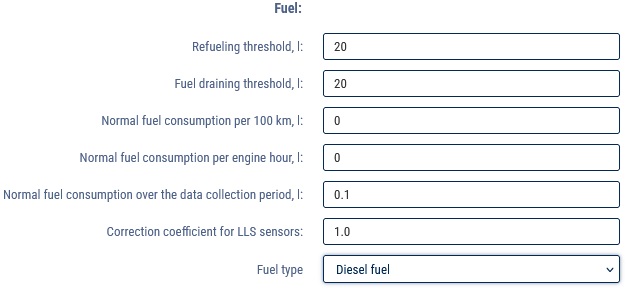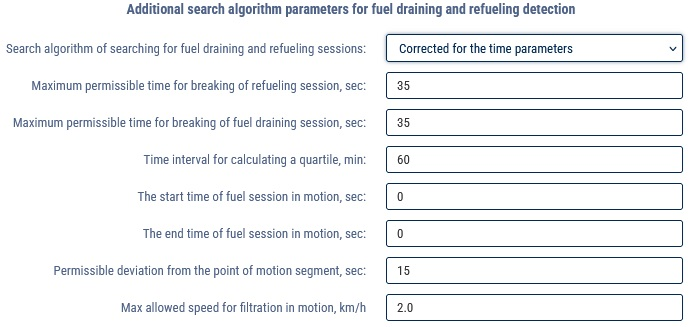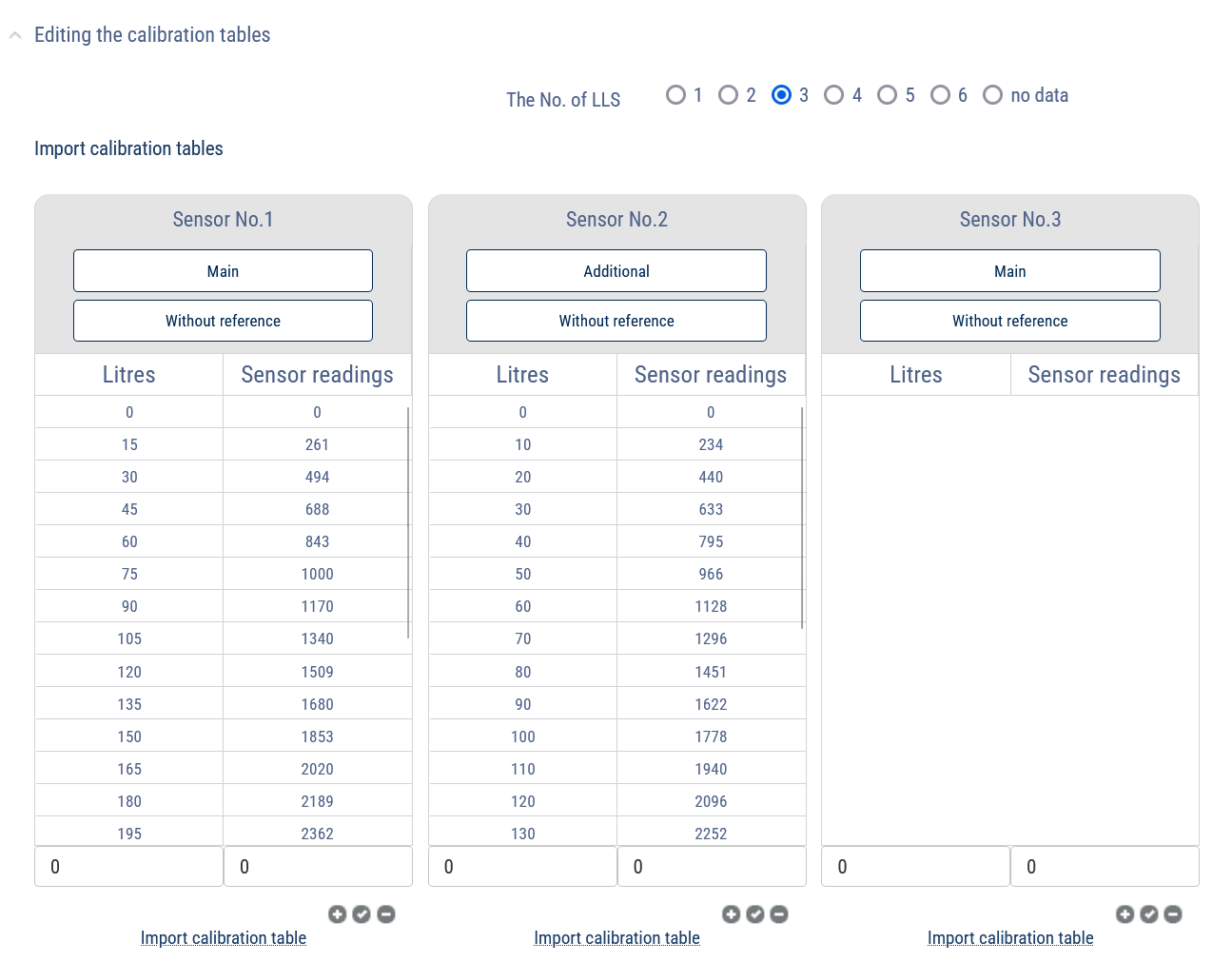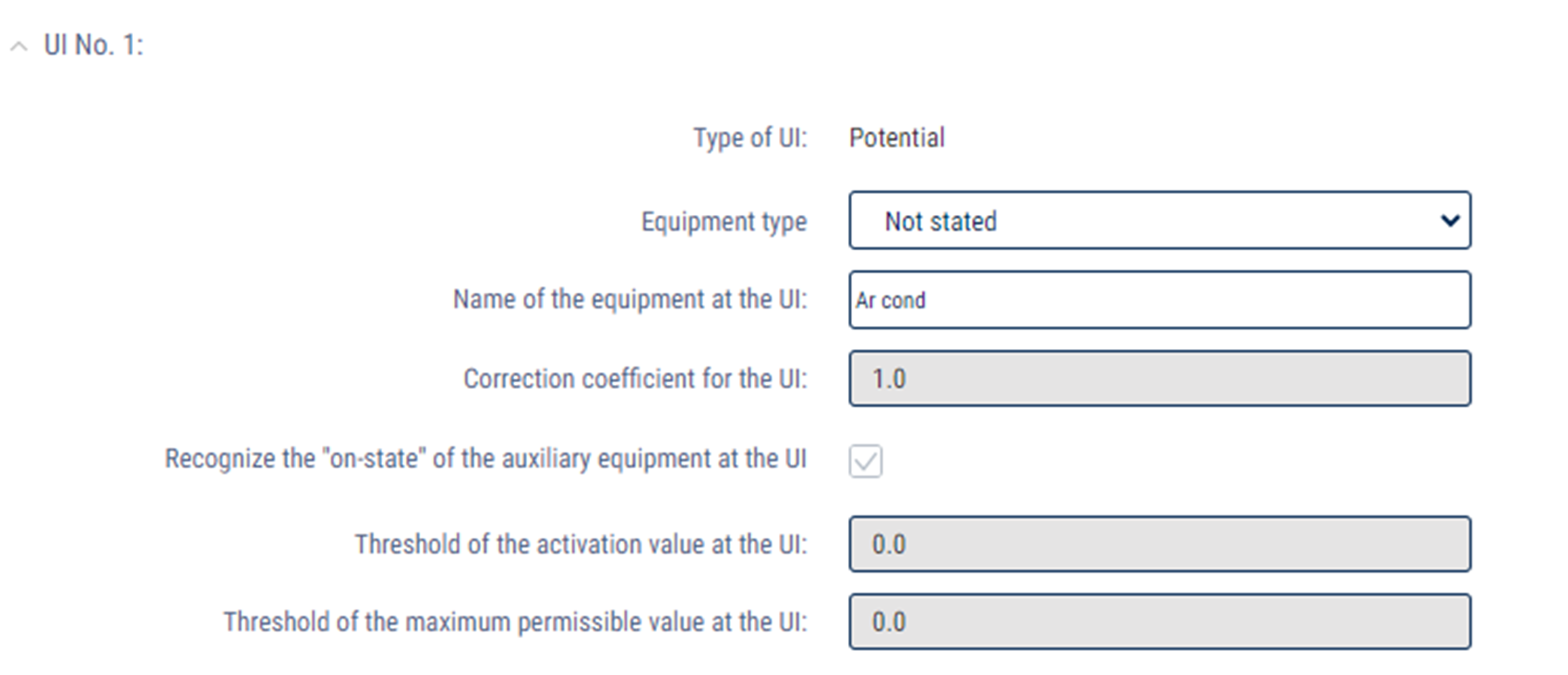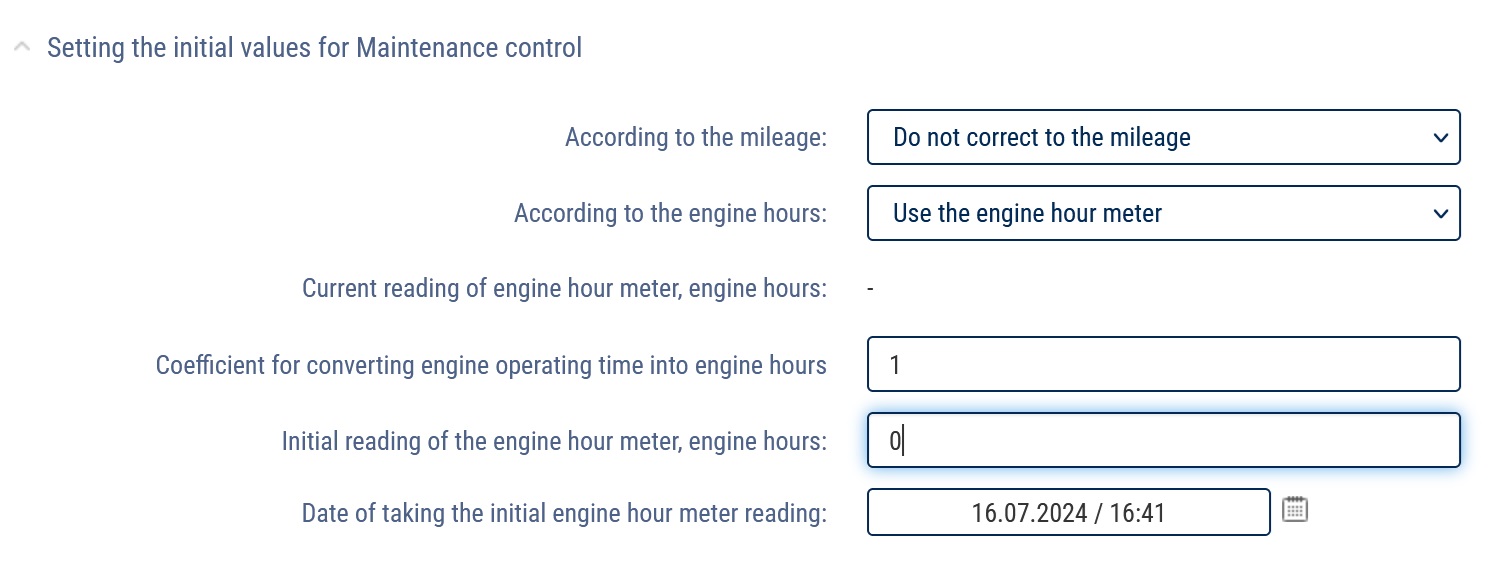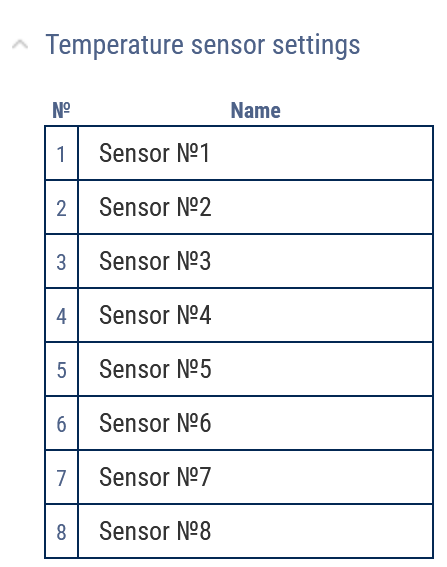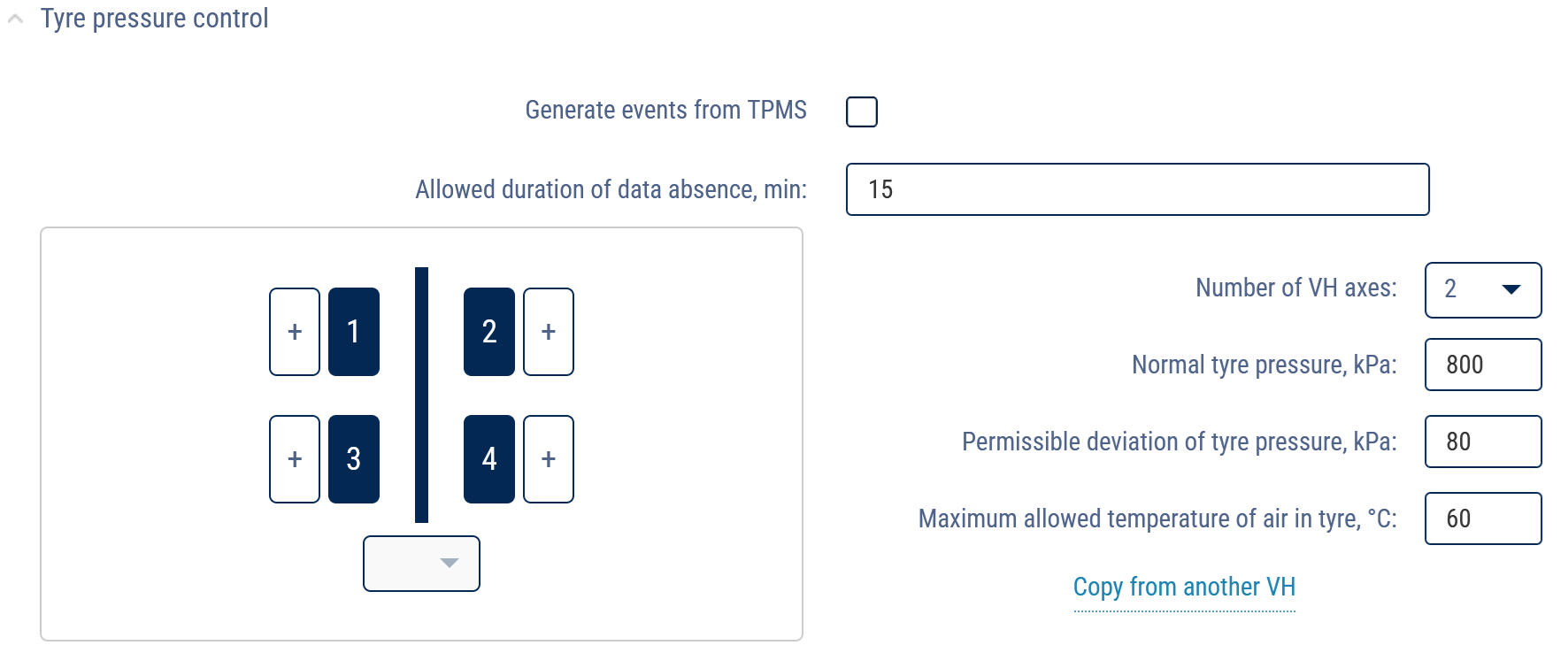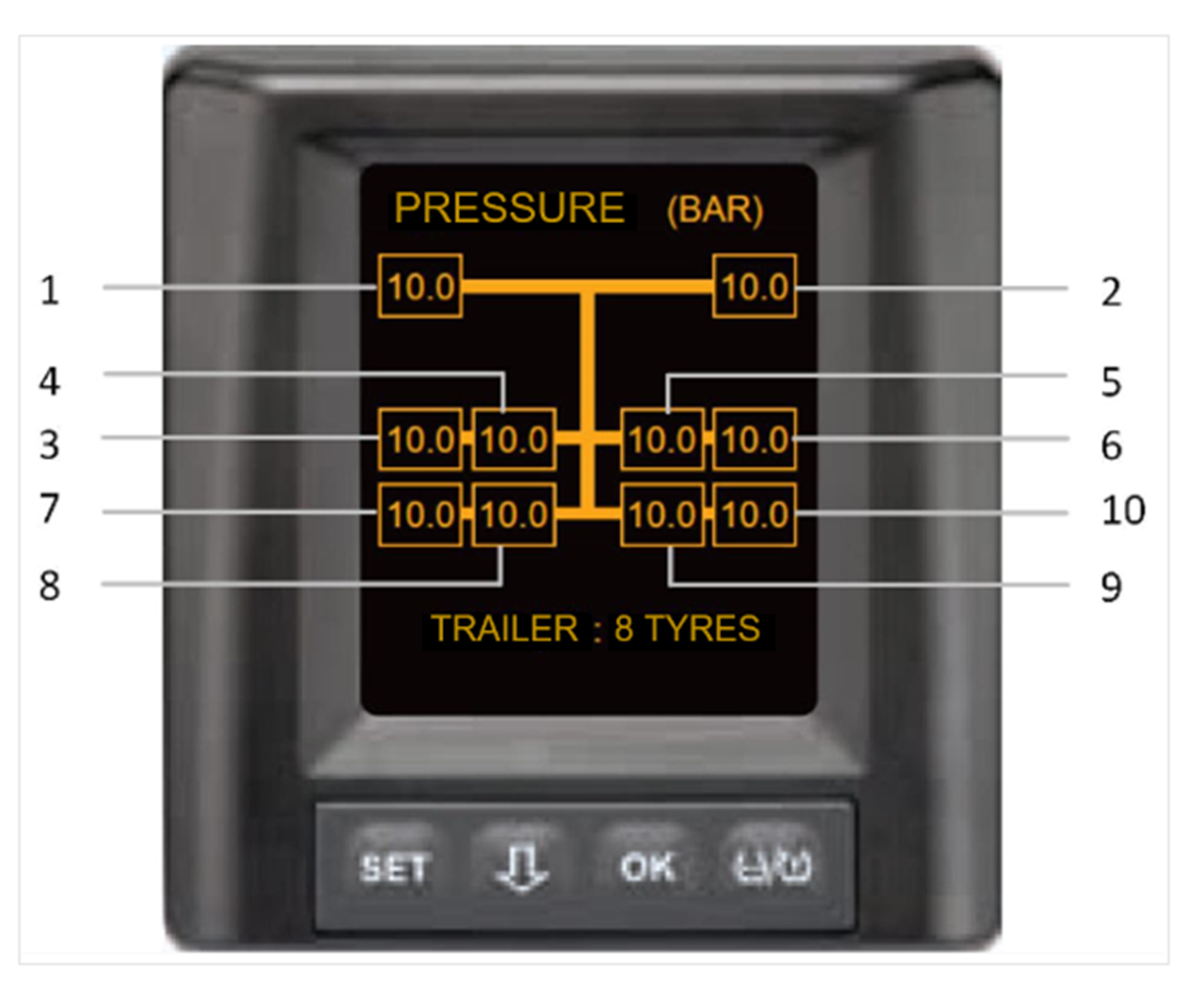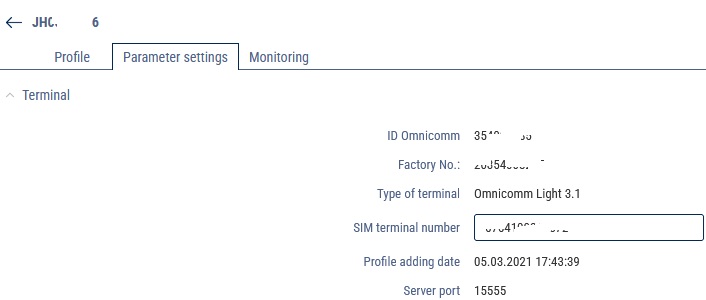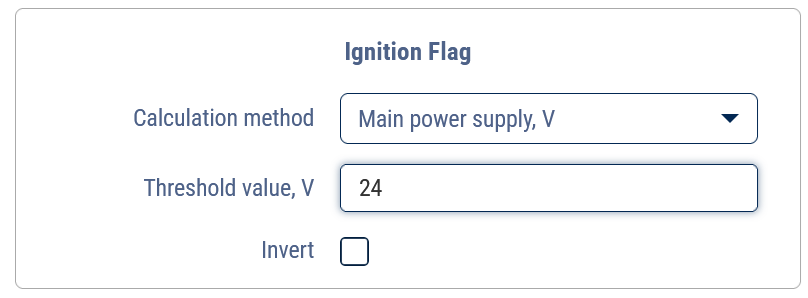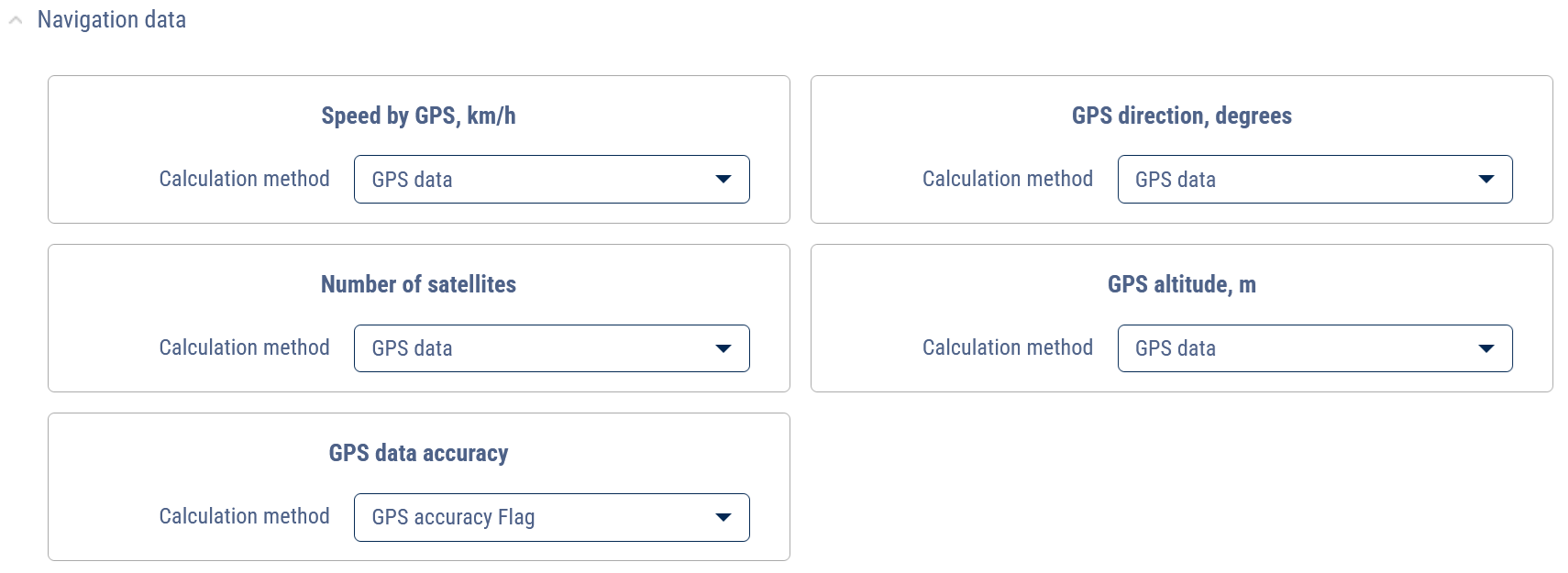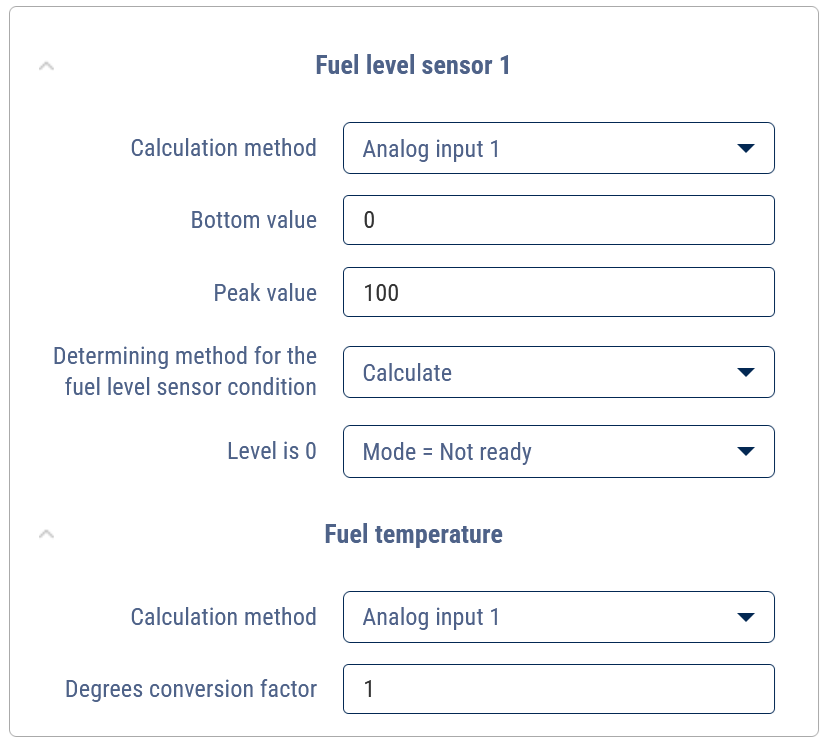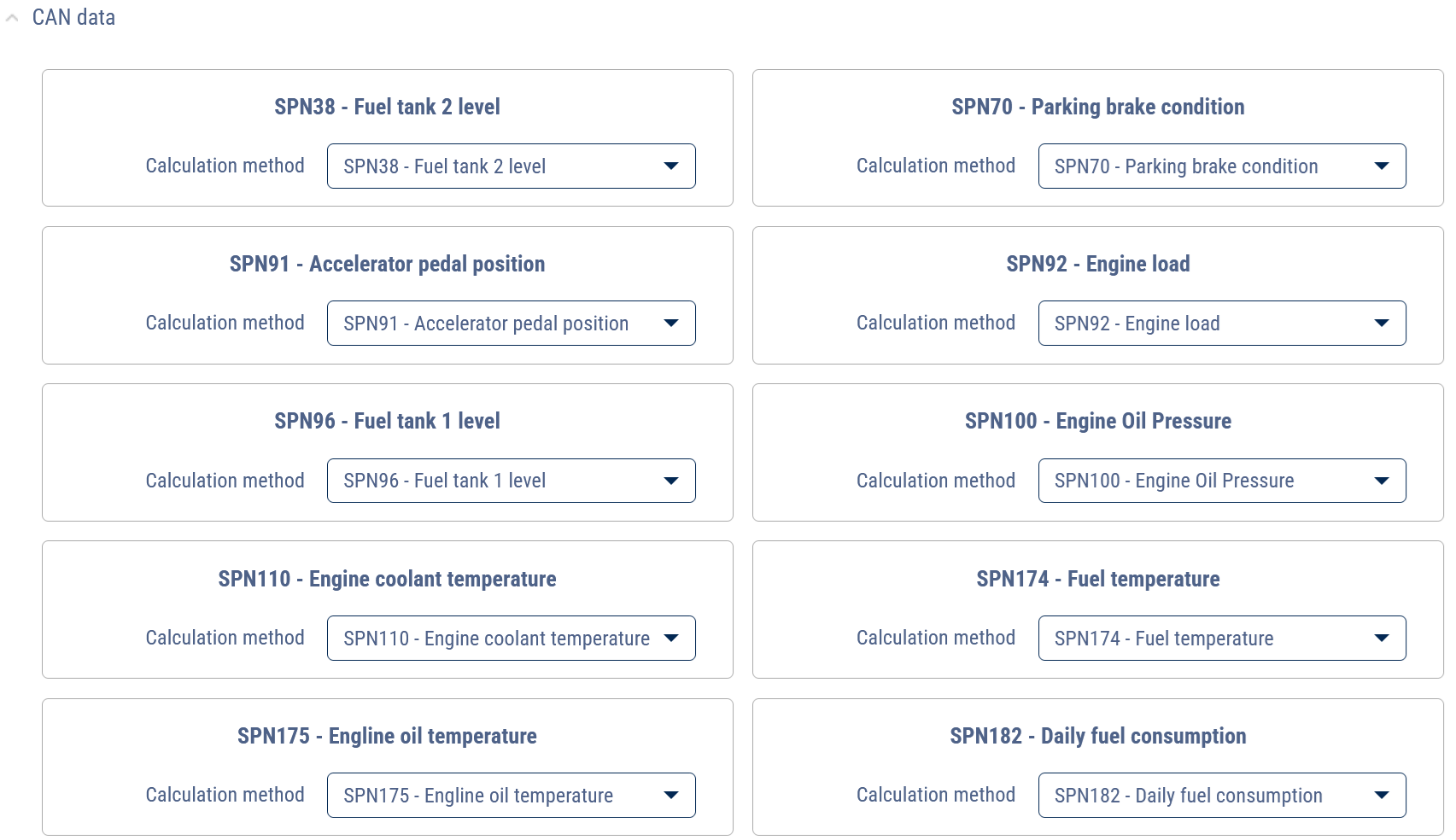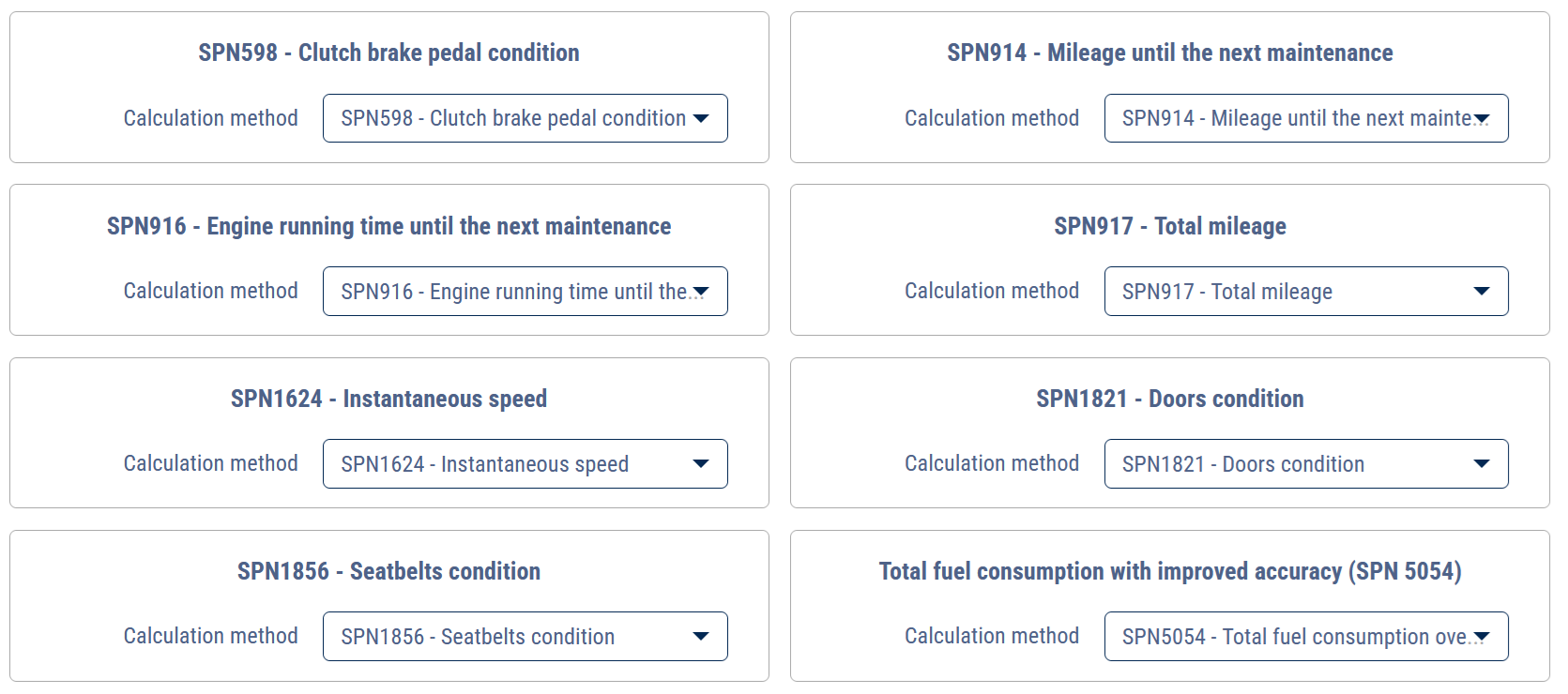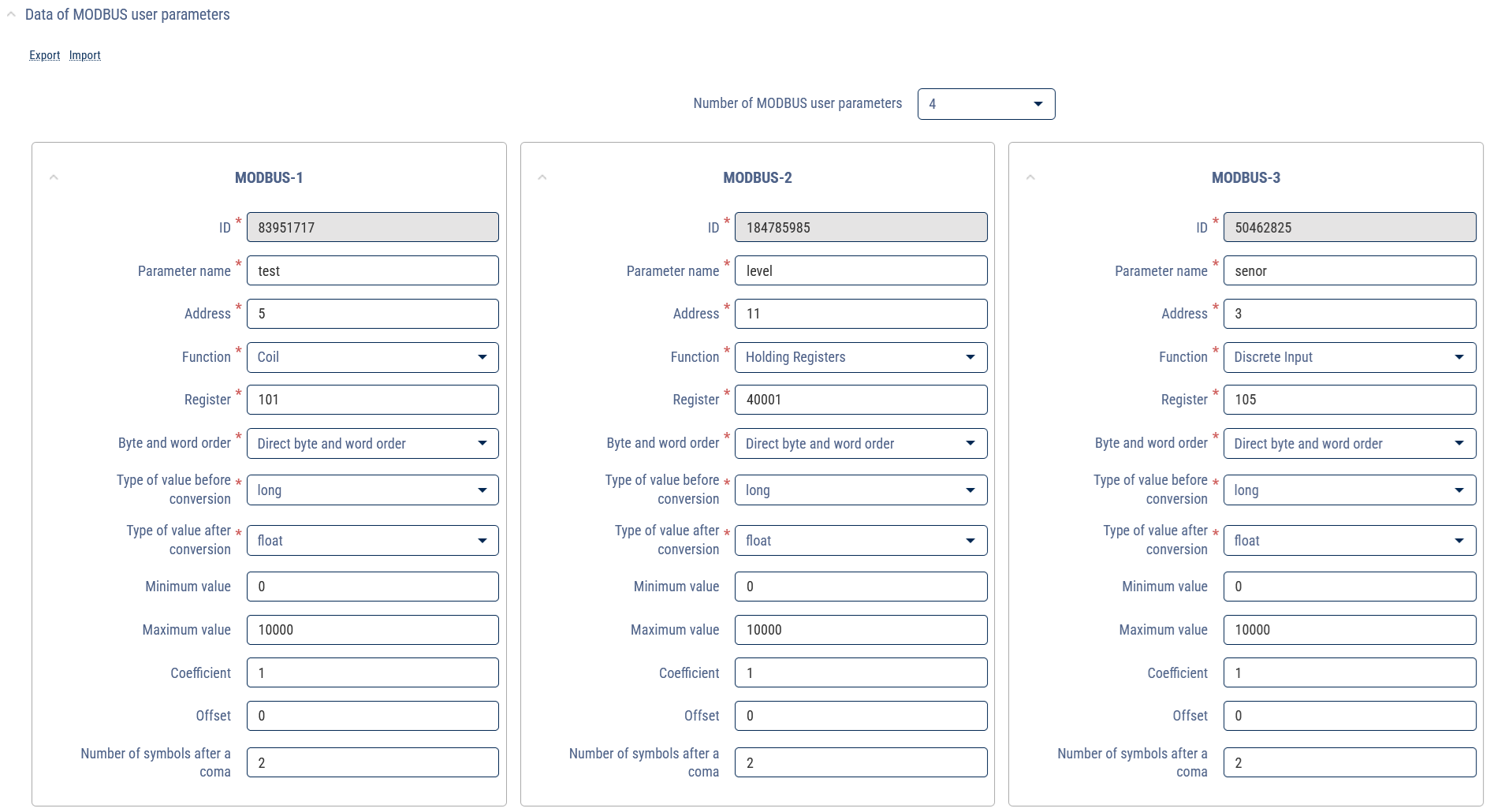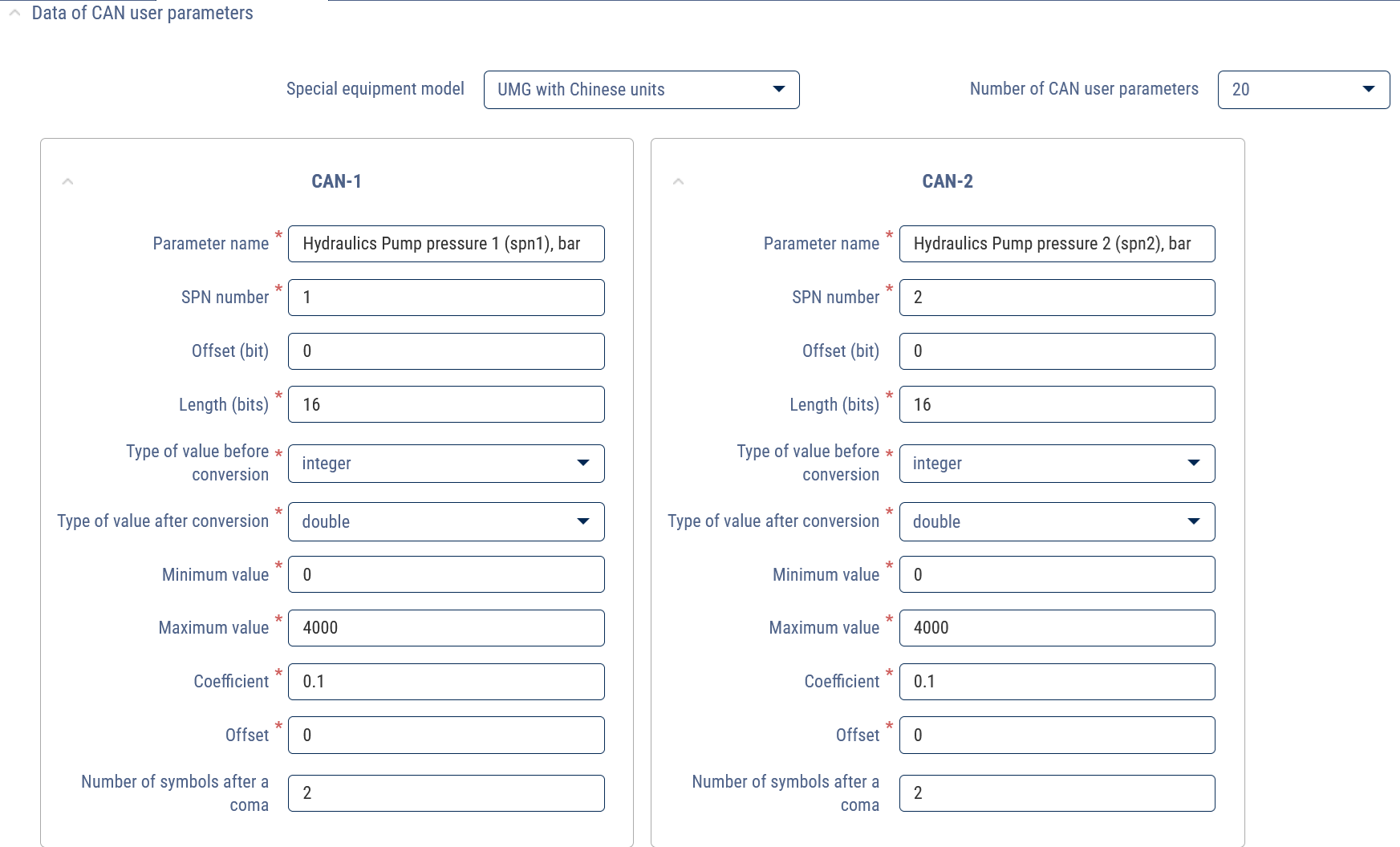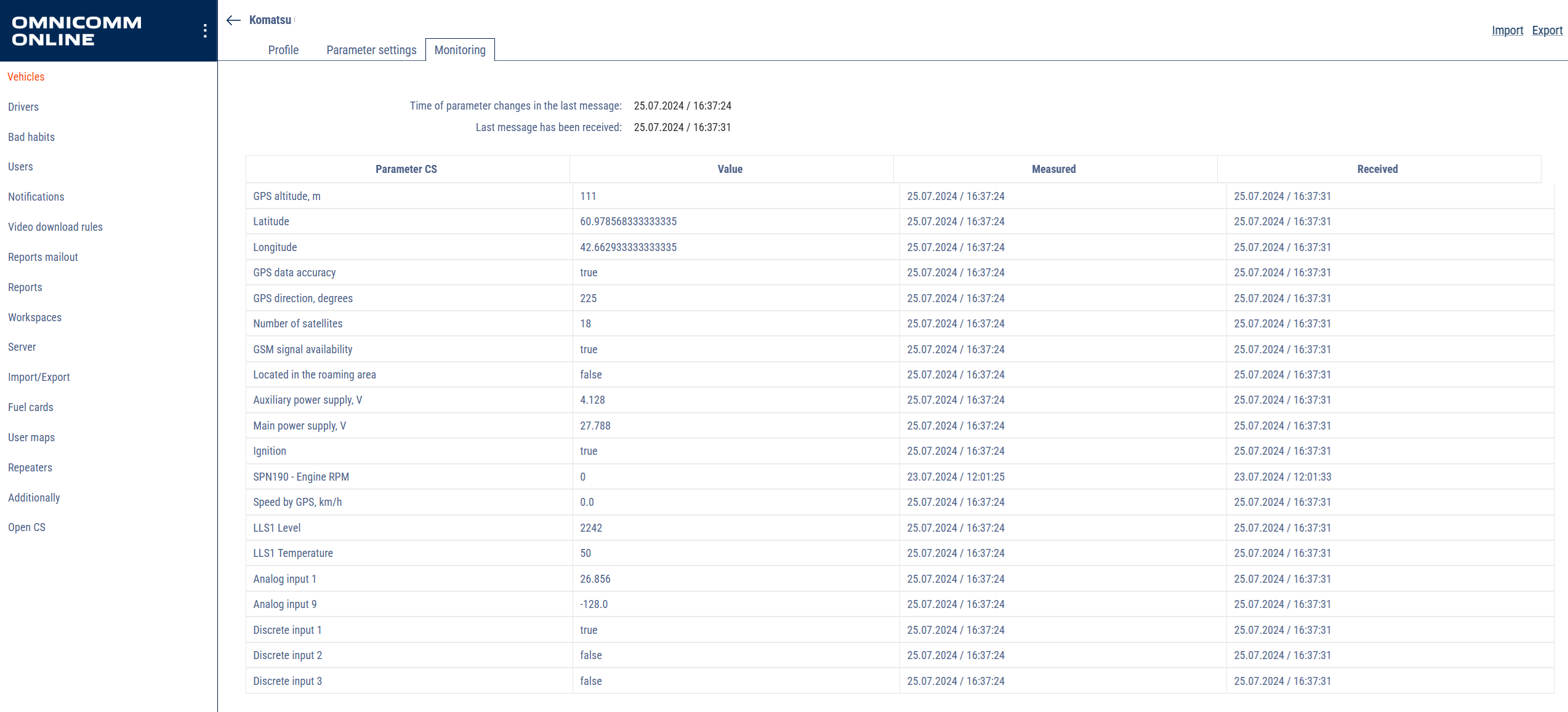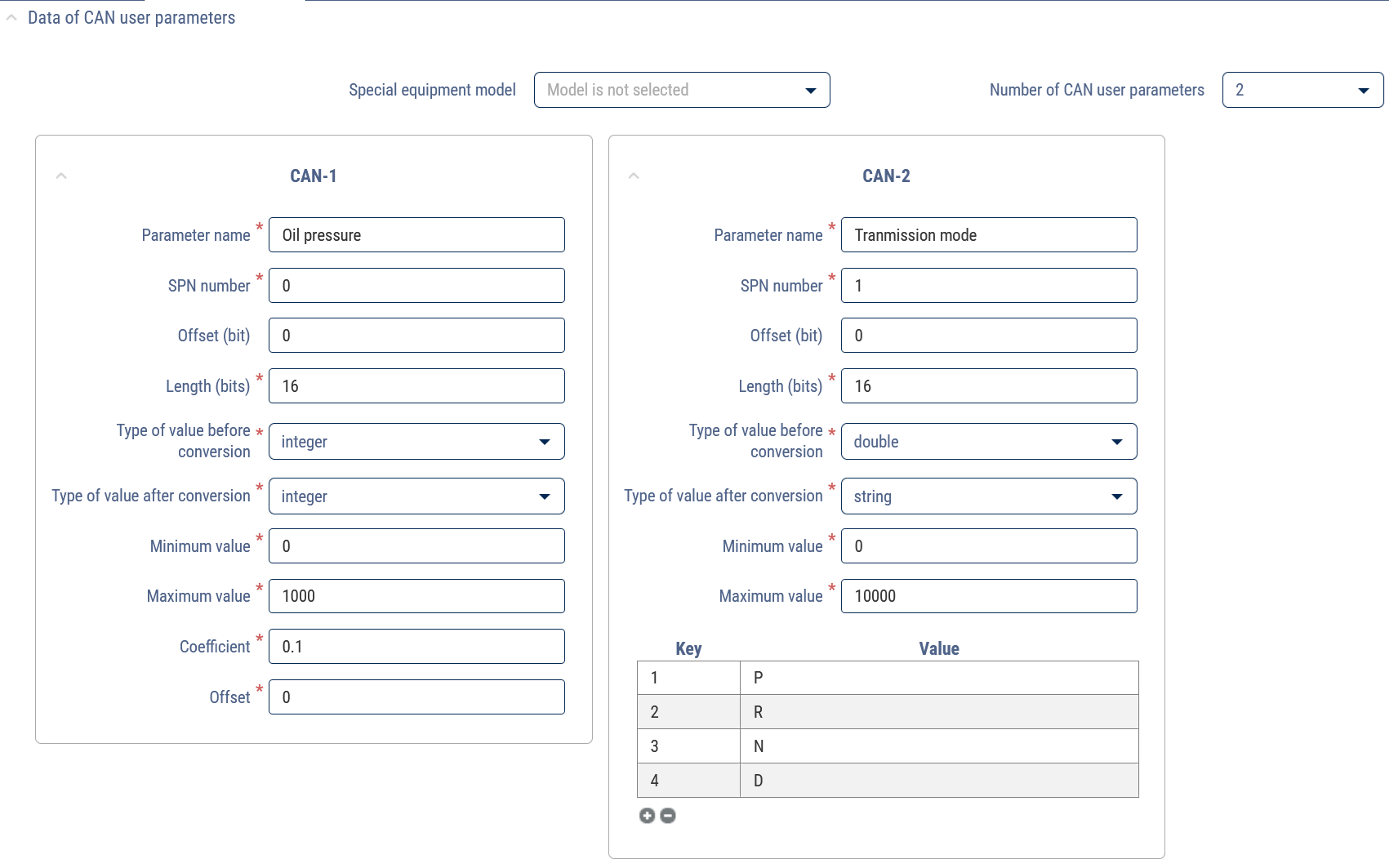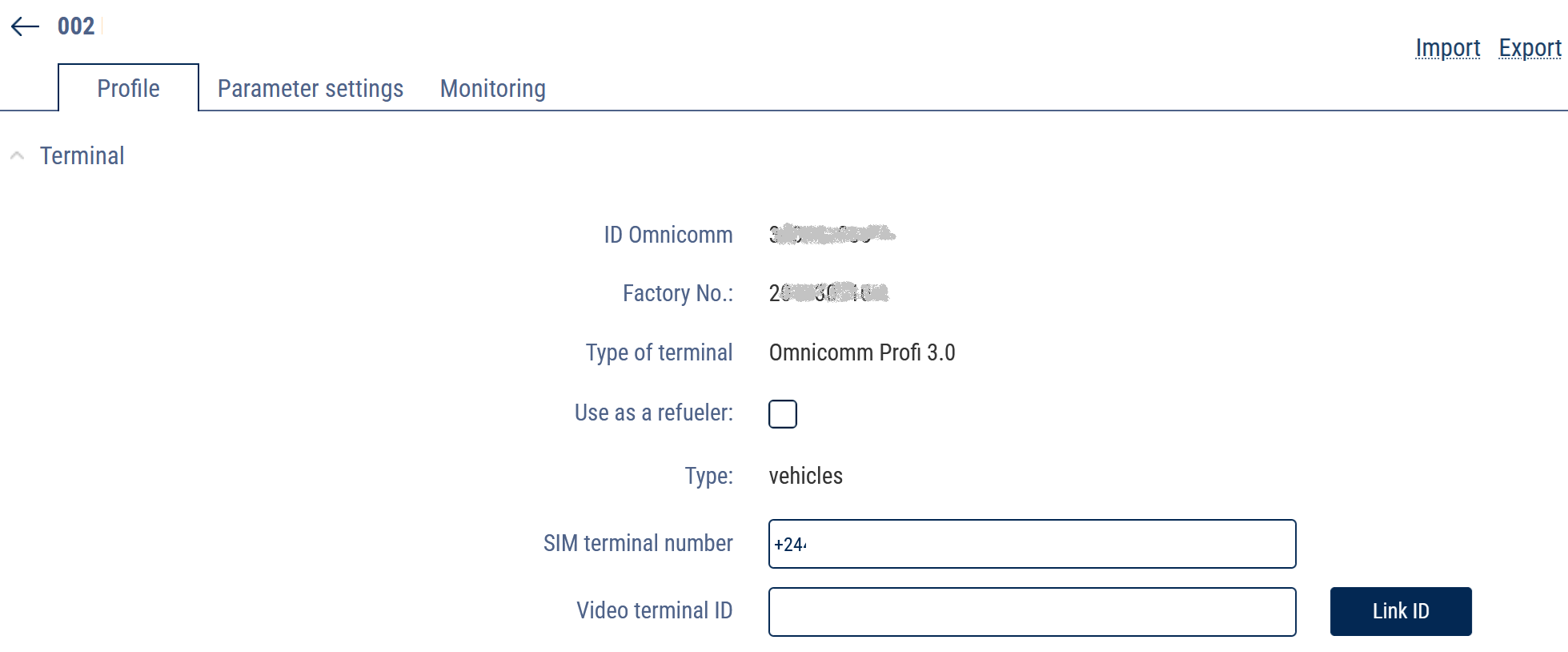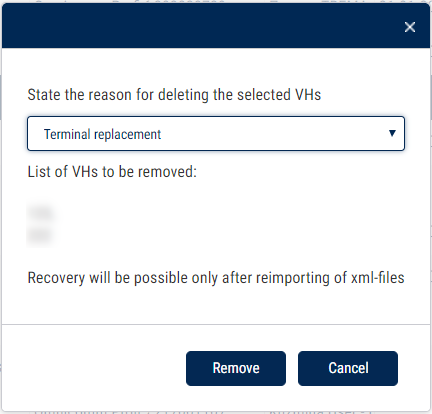Managing the list of vehicles
Log in to Omnicomm Online under your personal account or user account.
In the “Administration” section, open the “Vehicles” tab. Following window opens:
“Raw data” displays the date and time of receiving the latest data from the communication server for each vehicle.
“New data on the CS” displays the availability of raw data that has not yet been processed. The possible options are “Yes”, “No”, “No subscriptions”. The “No subscriptions” value is displayed if the access code is specified incorrectly when configuring connection to the Communication Server or a vehicle is not registered on the Management Server.
“Last processed data” displays the time and date of data receipt, which were last processed in Omnicomm. Time and date are highlighted in color according to the settings of the vehicles list display (see Omnicomm Online. User Manual. Settings of Objects Tree). It also displays the data recalculation process in percentages or “ready” when the data recalculation is complete.
“Vehicle profile creation date” is the date and time when the profile data started to be processed in Omnicomm Online.
Vehicle search
In the search box:
- Enter part of a vehicle name or part of the identification number
- To search for several vehicles by identification numbers, enter identification numbers (parts of numbers) separated by commas (without or with spaces). For example: 346000101,2360154,202360154 or 346000, 2360154, 202360
- To search for multiple vehicles by name, enter “name:” and vehicle names (parts of names) separated by commas (without or with spaces). For example, name:Iveco,Man
Adding
In the “Administration” section open the “Vehicles” tab and click the “Add” button. Following window opens:
“Vehicle name” - Enter the name of a vehicle to be displayed in Omnicomm Online.
“Terminal type” - Select the type of terminal installed on a vehicle. Possible values: Omnicomm or one of the third-party terminals.
“Server port” - The server port is set automatically depending on the type of selected terminal.
“Factory number” - Enter the factory number listed on the terminal.
To add a vehicle and proceed to the vehicle profile setup, click “Save and proceed to setup”.
To add a vehicle without setting up the profile, click the “Save” button.
When you go to the settings, the window of editing the vehicle profile opens:

Profile settings
In the vehicle profile setting in the “Profile” tab, specify the parameter values:
In the “Terminal” section:
“Omnicomm ID” displays the identification number of the terminal installed on a vehicle.
“Factory number” shows the factory number of the terminal, which is set at factory.
“Terminal” shows the terminal model.
“Use as a fuel dispenser” (only for Omnicomm Profi terminals) enables/disables the ability to register filling, draining and dispensing of fuel through the fueling gun.
“Type” is the type of vehicle.
“Terminal SIM number” - Enter the phone number of the SIM card installed in the terminal.
“Video terminal ID” - Enter the identification number of Omnicomm OKO Light video terminal installed on a vehicle. Click the “Bind ID” button. ID binding is used to match video files received from Omnicomm OKO Light video terminal with telematics data from the terminal also installed on a vehicle.
In the “Vehicle” section:
“Start date of processing in Omnicomm Online” - date and time of start of data processing by profile in Omnicomm Online.
“Vehicle name” is the name of the vehicle. For example: 10 RU А 123БВ. The vehicle name must be unique for Omnicomm Online. The field “Vehicle name” must not be empty and must not exceed 100 characters.
“Fleet number” is the internal number of a vehicle in an organization.
“Purpose” is the purpose of a vehicle in the organization.
“Brand” is the brand of a vehicle.
“Model” is the model of a vehicle.
“Color” is the color of a vehicle.
“Year of manufacture” is the year of manufacture of a vehicle.
“VIN” is Vehicle Identification Number.
“Engine number” is the engine number of a vehicle.
“Chassis number” - chassis number of a vehicle.
“Vehicle registration plate” shows registration number of a vehicle.
“Manufacturer, model, engine power” - Specify the characteristics of a vehicle engine.
“Vehicle registration certificate” - Enter the number of a vehicle registration certificate.
“Vehicle passport” - Enter a vehicle passport number.
“Lease agreement number” - Enter the agreement number, if a vehicle is leased.
“Vehicle category” - Select the category of a vehicle. Possible options:
• Categories A, B, C, D, D, E, F according to the traffic rules of the Russian Federation
• SPEC category - custom vehicles
“Groups”. Click on the Select group hyperlink for a vehicle being edited and select groups from the list to which a vehicle will belong.
“Mileage and speed calculation method” allows you to select which data and method to use to calculate mileage and speed. Possible options:
- “According to terminal data (without excluding coordinate outliers)“ - Omnicomm Online calculates mileage using data received from terminals without excluding drift coordinates.
- “According to terminal data (excluding coordinate outliers)“ - Omnicomm Online calculates mileage based on data received from terminals with drift coordinates cut-off
- “Speed by GPS coordinates, mileage by GPS coordinates (excluding coordinate outliers)“ - Omnicomm Online calculates mileage by GPS coordinates, cutting off invalid GPS coordinates or coordinates determined by less than 4 satellites.
- “Speed by GPS coordinates, mileage by GPS coordinates (without excluding coordinate outliers)“ - Omnicomm Online calculates mileage by GPS coordinates, without cutting off invalid GPS coordinates or coordinates determined by less than 4 satellites.
- “According to speed sensor data” - Omnicomm Online calculates mileage based on the vehicle's regular speed sensor data, taking into account the correction factor (for cars only)
For the standard speed sensor, set the “Speed sensor correction factor” and “Mileage correction factor”, which provide correction of the speed sensor readings.
“Maximum allowable acceleration, m/s²” - Enter the value of the maximum allowable acceleration of a vehicle (lateral, acceleration, braking), above which a sharp change in the nature of a vehicle movement is detected.
“Track parking for more than, min:sec” - Check the box and specify the number of minutes after which a vehicle parking will be registered if the corresponding conditions are met. The conditions for parking/stops detection depend on the parameter “Take ignition into account when determining parking and stops”.
“Track stops for more than, min:sec” - Check the box and specify the number of minutes after which a vehicle stop will be registered if the corresponding conditions are met.
“Take ignition into account when determining parking and stops” - Check the box if it is necessary to register parking and stops taking into account the state of vehicle ignition. The selection is only active when “Track parking for more than, minutes” or “Track stops for more than, minutes” is enabled.
Condition of parking/stops registration taking into account the state of ignition of a vehicle:
• More time has elapsed since the ignition was switched off than specified in the “Track parking for more than, minutes” parameter
• Vehicle speed less than 2 km/h
The condition of parking/stops registration without taking into account the state of ignition of a vehicle:
• Vehicle speed less than 2 km/h for all consecutive events with raw data
• The distance between any events with raw data is less than 800 m
• The time interval between the first and the last event with raw data is greater than the value of the parameter “Track stops for more than, minutes”.
• The time interval between the first and last raw data event does not include periods of data unavailability
“Take into account engine speeds” - Check the box if it is necessary to take into account engine speeds when rendering reports.
“Minimum duration of data unavailability” is the maximum time between the current and the last valid raw data event, after which Omnicomm registers the event of data “unavailability”.
“Drift by mileage” - Specifies thresholds for movement and mileage to cut off drift coordinates while a vehicle is parked with the GPS module running. When a vehicle is moving at a speed of more than 2 km/h, the drift coordinates are not cut off. The values “Drift by mileage, m” (from 0 to 100 m) and “Drift by mileage, m” (from 0 to 100 m) are adjusted taking into account the average speed of a vehicle. The default value for both parameters is 20 m.
In the “Engine” section:
“Correction factor for RPM meter” is the factor for converting the number of pulses from the RPM meter to the number of revolutions.
“Engine RPM limit” is the engine RPM value, when exceeded, Omnicomm Online registers a vehicle operation under the load limit. The default value is 5,500 rpm.
“Engine idle RPM level” is the engine RPM value, when exceeded, Omnicomm Online registers vehicle movement. The default value is 1,000 rpm.
In the “Fuel parameters” section:
“Fuel tanks” - Select the number of fuel tanks installed on a vehicle:
- “Main only” means only one fuel tank is installed on a vehicle
- “Main and additional” means two fuel tanks are installed on a vehicle. For refuellers, the main tank is the reservoir, the additional tank is the engine fuel tank. For the vehicle, the main tank is the engine fuel tank, the additional tank is the fuel tank for the optional equipment.
- “Multitank” means up to 6 fuel tanks are installed on a vehicle. Available to users with established rights to objects: Access to Multitank (see Adding and editing a user profile).
Parameters of the main fuel tank

The units of fuel parameters liters or gallons are specified depending on the server settings.
“LLS5”:
“Monitor fuel quality LLS 5” - Check the box to monitor fuel quality using Omnicomm LLS 5 level sensors.
“Autotuning coefficient change threshold, %“ - Specify the allowable value of autotuning coefficient change, if exceeded, the “Correction coefficient change threshold exceeded” event will be registered. The default value is 7. Possible values: 0 to 100.
“Autotuning factor stabilization interval, seconds” - 0 (unchangeable value).
“Fuel”:
“Parameters of the main fuel tank” for the vehicle and the additional tank for the fuel dispenser:
“Refueling threshold, l” (from 0 to 28,000) is the volume of fuel by which the total volume of fuel of a vehicle must be increased in order for fuel refueling to be registered. The default value of the refueling threshold is 7% of the tank volume.
“Drainage threshold, l” (from 0 to 28,000) is the volume of fuel by which the total volume of fuel of a vehicle must be reduced in order for the fuel drainage to be registered. The default value of the drain threshold is 7% of the tank volume.
“Average consumption per 100 km, l” (from 0 to 1,000 with accuracy to 0.1 l) is the volume of fuel consumed by a vehicle per 100 km (only for cars).
“Average consumption per engine hour, l” (from 0 to 1,000 with accuracy up to 0.1 l) is volume of fuel consumed by a vehicle for an hour of engine operation (only for cars).
“Average fuel consumption for data collection period, l” (from 0 to 1,000 with accuracy up to 0.1 l) is the volume of fuel consumed by a vehicle during the time between taking readings from the sensor (only for cars).
“Correction factor for fuel sensors” (from 0.01 to 1.99) is used to correct readings of Omnicomm LLS fuel level sensors.
“Fuel type” - Select the type of fuel to calculate the amount of CO2 emissions. Possible options: gasoline, diesel and not specified.
“Parameters of fuel data processing algorithms”:

“Rough filter” is the number of fuel level measurements before and after refueling/draining that are used in the refueling/draining search algorithm to filter out fuel level fluctuations. Coarse filter size (5 - 50), the default value is 15.
The fill/drain thresholds and coarse filter size are selected based on the tank volume, the amount of fill/drain detected and the vehicle operating conditions.
In cases where operating conditions and vehicle characteristics cause large fluctuations in fuel level, it is recommended to increase the values of refueling/drain thresholds and coarse filter value relative to default values.
In cases where operating conditions and vehicle characteristics have little effect on fuel level fluctuations, it is allowed to reduce the values of refueling/drain thresholds and coarse filter value relative to default values.
“Buffer length” - Specify the buffer length for the fuel data smoothing algorithm. Coarse filter size (10 - 100), the default value is 35.
“Additional parameters for the algorithm to search for refills and drains”:
For the algorithm for searching for refueling and draining “Take time parameters into account”:
“Maximum allowable refueling interruption time, sec” is the time interval in the process of refueling during which the fuel level may not rise. The default value is 30 s.
“Maximum allowable draining interruption time, sec” is the time interval in the process of draining, during which the fuel level may not drop (taking into account average fuel consumption). The default value is 30 s.
The setting of time parameter values should be done by considering the "Data collection period" value and analyzing specific areas where no drain/fill events were detected.
Quartile is the arithmetic mean of some number of points with fuel raw data before the start or after the end of fuel operation with a quarter of minimum and maximum values screened out and is used to determine the fuel level before and after refueling/draining.
The quartile is calculated by the number of fuel level values obtained during the time specified in the “Time interval for quartile calculation, min” parameter.
“Time of fuel operation start in motion, sec” is the allowable time of fuel operation start in motion.
“Time of fuel operation end in motion, sec” is selected depending on the filtering value set in the terminal.
Recommended values for filtration levels:
• Disabled - 0
• Weak - 60
• Average - 120.
• Strong - 200.
• Maximum - 300.
“Allowable deviation from the movement section boundary, sec” is the time during which the fuel level is current at the start or end of movement.
“Maximum allowed speed for filtering at speed, km/h” - Specify the speed (with filtering enabled) above which fuel operations will not be displayed in reports.
“Fuel weight calculation”:
“Method of mass calculation” - Select the method of fuel mass calculation. Possible options:
• by level, temperature and standard density
• by level and actual density
For the “by level, temperature and standard density “ method:
“Fuel average density at 20°C, kg/m3” - Enter the fuel standard density. The default value is 860.0 kg/m3.
“Temperature data source” - Select the universal input to which the temperature sensor is connected.
“Temperature density factor” - Enter the temperature density factor. The default value is 0.7.
For the “by level and actual density” method:
“Density data source” - Select the universal input to which the density sensor is connected.
Multitank parameters
• Select Multitank
• Specify the number of tanks
Tank parameters
Specify the following parameters for each tank:
“Tank type” - Select the tank type. Possible variants: consumption tank, non-consumption tank without output counter.
“Name” - Enter the name of the tank.
For consumption and non-consumption tanks, specify the fuel parameters in the same way as for the main tank.
Select the number of fuel level sensors installed on a vehicle.
When loading multiple tables from a file, specify the network addresses of the fuel level sensors.
For each fuel level sensor, select the tank (“Main” or “Additional”) in which the fuel level sensor is installed.
In case of Multitank, select the tank in which the sensor is installed by clicking Unlinked.
Highlight with the cursor the row whose values you want to change. In the input cells below the table, enter new values for this row of the table. To enter row values into the table, press ![]() .
.
To add/remove a table row, press ![]() .
.
In the “Universal input settings” section:
Analog universal input
“Universal input type” displays the “analog” input type, set during terminal setup.
“Name of the equipment on the universal input” - Enter the name of the sensor or the name of the measured value.
“Universal input correction factor”.
The default value is 1.
“Take into account the switching state of additional equipment on the universal input” registers the switching on of additional equipment at the universal input.
“Threshold value of switching on the universal input” - For analog sensors it is recommended to set the value beyond the sensor measurement range, which will help to avoid registration of unnecessary sensor switching off events. When the “Take into account the switching state of additional equipment on the universal input” is turned off, the field “Threshold value of switching on the universal input” is not editable.
“Take into account exceeding the allowable value at the universal input” registers exceeding of the allowable value at the universal input.
“Threshold of maximum allowable value on universal input” - Enter the measured value, when exceeded, Omnicomm will register operation with exceeded allowable value. If “Take into account exceeding the allowable value at the universal input” is turned off, the field “Threshold of the maximum allowable value at the universal input” is not available for editing.
To save all changes, click the “Save” button.
Potential universal input
“Universal input type” displays the “potential” input type, set during terminal setup.
“Name of the equipment on universal input” - Enter the name of the sensor or the name of the measured value.
Pulse universal input
“Universal input type” displays the “pulse” input type, set during terminal setup.
“Name of the equipment on universal input” - Enter the name of the sensor or the name of the measured value.
“Universal input correction factor” is recommended to be changed only if the input calibration has been incorrectly performed.
“Take into account the switching state of additional equipment on the universal input” registers the switching on of additional equipment at the universal input.
When the “Take into account the switching state of additional equipment on the universal input” is turned off, the field “Threshold value of switching on the universal input” is not editable.
“Take into account exceeding the allowable value at the universal input” registers exceeding of the allowable value at the universal input.
“Threshold of maximum allowable value on the universal input” - Enter measured value, when exceeded, Omnicomm will register the operation with exceeding the allowable value. If “Take into account exceeding the allowable value at the universal input” is turned off, the field “Threshold of the maximum allowable value at the universal input” is not available for editing.
In the section “Setting initial values for maintenance control”:
“Mileage record” allows you to select the data source to record a vehicle mileage for control over maintenance. Possible options:
- “Ignore mileage” - Mileage calculation for maintenance control will not be performed
- “Use odometer” - The calculation is based on the odometer readings set in the vehicle profile in the “Mileage and speed calculation method” parameter. Possible options: from terminal (with drift), from terminal (without drift), speed by GPS, mileage by GPS coordinates, from speed sensor
“Initial odometer value, km” - Enter the odometer reading mileage value.
“Date and time of odometer initial reading” - Enter the date and time when the odometer reading was taken.
“Current odometer value, km” displays the mileage value calculated by Omnicomm using the odometer. To display the current odometer value at the first installation or adjustment, you must save the changes to the vehicle profile and then reopen the vehicle profile.
- “Use CAN-bus odometer value” - The mileage calculation for maintenance control will be performed according to the values received from the CAN-bus
“Current odometer value, km” displays the last mileage value sent by the terminal based on the CAN-bus odometer readings.
“Engine hours record” allows selecting the source of data to record vehicle’s engine hours for control over maintenance.
Possible options:
- “Do not count engine hours” - Engine hours will not be counted for the purpose of maintenance control
- “Use engine hour meter” - the calculation of engine hours will be based on the readings of a vehicle's engine hour meter and engine running time.
“Coefficient for conversion of engine operation time into engine hours” - Specify the coefficient for conversion of engine operation time into engine hours specified in a vehicle passport.
“Initial counter value, eh” is the value of the engine hour meter.
“Date and time when the initial odometer reading was taken” - Enter the date and time when the engine hour meter reading was taken.
- “Use CAN-bus hours value” - The calculation of the engine hours for the maintenance check will be performed using the values received from the CAN-bus.
“Current hour meter value, eh” - the number of hours received from the CAN-bus.
In the “Assigning a driver to a vehicle” section:
“Driver registration by applying a tag” - Check the checkbox to register the driver by applying an RFID card or iButton key.
The assignment of a driver to a vehicle is automatically terminated when this driver is assigned to another vehicle or when another driver is assigned to the same very vehicle.
“End registration with ignition off” - Check the box to end registration when ignition off is detected
“End registration by removing the tag from its holder” - check the checkbox to end enrollment when it is detected that the iButton key or RFID card is removed from the holder.
“Restore registration if tag is re-applied within specific time” - Specify the time within which the RFID card or iButton key must be re-applied to automatically restore driver registration. The field is active only if the “End registration by turning off the ignition” or “End registration by removing the tag from its holder” parameter is enabled.
In the “Setting temperature sensors” section:
“No.” shows the serial number of the temperature sensor.
“Name” - Enter the name of the temperature sensor. For example, a cabin. The maximum number of characters is 16.
In the “Tyre pressure monitoring” section:
“Generate events from TPMS” - Check the checkbox to process data from the tire pressure monitoring system.
“Allowable duration of data unavailability, minutes” - Enter the value after which the “No data from tire pressure monitoring system” event will be registered in case of no data. Possible values: 0 to 1140 min. The default value is 15.
“Number of vehicle axles” - Select the number of vehicle axles. Possible values: 1 to 13.
When using TPMS Conti Pressure Check tire pressure monitoring system, the axles and wheels must match the TPMS Conti Pressure Check configuration:
The wheel position data in TPMS Conti Pressure Check is transmitted in CAN J1939 format. The wheels are numbered from left to right from the first (top) axle, so that the first wheel is located on the driver's side.
“Correct tire pressure, kPa” - Enter the tire pressure value set by a vehicle manufacturer. Possible values: 0 to 1,000 kPa.
“Allowable deviation of tire pressure, kPa” - Enter the value of allowable deviation from normal tire pressure, above which the “Tire pressure drop” event is registered.
“Maximum allowable tire temperature, °С” - Enter the value of tire temperature, if exceeded, the “Tire temperature rise” event is registered. Possible values: -125 to 125 °C. The default value is plus 60 °C.
To copy axle, wheel and tolerance settings from another vehicle, click the Copy from another vehicle link.
In the “iQFreeze” section:
“Process data from iQFreeze” - Check the box to control data from iQFreeze.
“Allowable duration of data unavailability, minutes”. Possible values: 0 to 1,440 min. The default value is 15 min
“Allowable upward deviation of the CHU temperature from the set temperature”. Possible values: 0.00 to 100.00 °C
“Allowable downward deviation of the CHU temperature from the set temperature”. Possible values: 0.00 to 100.00 °C
In the “CAN threshold values” section:
Add the required CAN parameters and specify the values which are as follows:
“Correction factor” - Enter the value of the correction factor.
“Switching threshold” - Enter measured value, when it reaches which Omnicomm will register switching on.
“Lower threshold of nominal values” - Enter the measured value, above which Omnicomm will register operation at nominal values.
“Upper threshold of nominal values” - Enter measured value, when exceeded, Omnicomm registers operation with exceeding the nominal value.
Parameter settings
Open the vehicle profile and go to the “Parameter settings” tab. A window opens, there you can specify the parameter values.
In the “Calculation method” fields, only the calculation methods supported by the selected third-party terminal are displayed. Before selecting the “Calculation method” options in the “Monitoring” tab, make sure that data from the planned “Calculation method” parameter is available. In the “Terminal” section:
“ID Omnicomm” is an identification number of the terminal installed on a vehicle. The ID number is automatically generated based on the unique ID of the terminal.
“Factory number” - Enter the factory number listed on the terminal.
“Terminal type” is the type of terminal installed on a vehicle.
“Terminal SIM number” - Enter the phone number of the SIM card installed in the terminal.
“Date when profile was added” is the time and date when the vehicle profile was added to Omnicomm Online.
“Server port” displays the server port for connection of the selected terminal.
System Parameters
In the “Ignition flag” section:
Select the parameter on the basis of which Omnicomm Online will register the event of turning on/off a vehicle ignition.
Possible values: • “Analog input”: This calculation method is set when an ignition key signal is connected to the analog input of the terminal. Omnicomm Online will detect the ignition switch on when the voltage on the analog input is equal or more than “Threshold value, V”
If it is necessary to register the ignition switch-on when the analog input voltage is less than the “Threshold value, V”, check the “Invert” checkbox.
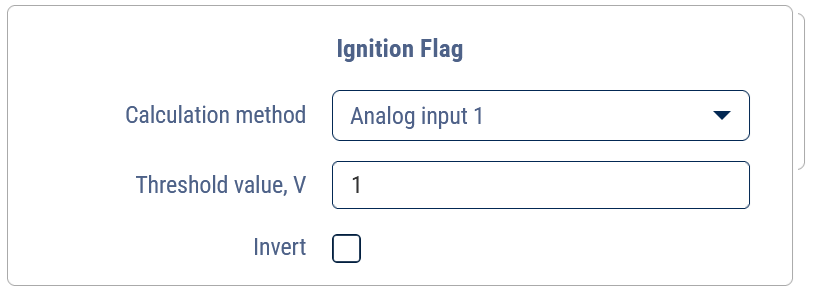 • “Ignition” flag. This calculation method is set if the terminal transmits ignition on/off data by ignition key position.
• “Discrete input”. This calculation method is set when an ignition key signal is connected to the discrete input of the terminal. Omnicomm Online will register the ignition switch on when a discrete input switch-on event is received from the terminal
If it is necessary to register the ignition switch on when a discrete input turn-off event is received, check the “Invert” checkbox.
• “Ignition” flag. This calculation method is set if the terminal transmits ignition on/off data by ignition key position.
• “Discrete input”. This calculation method is set when an ignition key signal is connected to the discrete input of the terminal. Omnicomm Online will register the ignition switch on when a discrete input switch-on event is received from the terminal
If it is necessary to register the ignition switch on when a discrete input turn-off event is received, check the “Invert” checkbox.
• “Presence of motion” flag. This calculation method is set if the terminal transmits a flag for the presence of movement. Omnicomm Online will register the ignition switch on when the terminal transmits the “Presence of motion” event
• “Engine RPM CAN” flag. This calculation method is set if the terminal transmits the engine speed value from the CAN-bus. Omnicomm Online will register the ignition switch on when receiving an event from the terminal with the presence of engine speed data from the CAN-bus
• “Main power supply”. This calculation method is set when the terminal transmits the main power supply. Omnicomm Online will register the ignition switch-on when the voltage of on-board vehicle network is equal to or more than “Threshold value, V”
If it is necessary to register the ignition switch-on when the on-board voltage of a vehicle is less than the “Threshold value, V”, check the “Invert” checkbox.
• “Power status” flag. This calculation method is set when the terminal transmits data on the availability of main power and backup battery power. Omnicomm Online will register the ignition switch on when the main power supply is present
• “Engine RPM”. This calculation method is set when the terminal transmits the RPM value. Omnicomm Online will register ignition switch on when the engine speed value is greater than 0
• “Always On”. This calculation method is the default value or set when ignition control is not available. Omnicomm Online will display the ignition is always on, so the calculation of parameters based on the ignition on/off data will not be performed
In the “GSM connection availability” section:
In the “Calculation method” field, select the parameter on the basis of which Omnicomm Online will register the presence of GSM connection.
Possible values:
• Always “Connection available”, This calculation method is the default value or is set if GSM connection monitoring is not required. Omnicomm Online will display constant GSM connection availability
• “GSM connection” flag. This calculation method is set in case the terminal transmits information about the presence of GSM connection. Omnicomm Online will register the presence of GSM connection, when receiving the GSM connection event from the terminal
• GSM signal reception level. This calculation method is set when the terminal transmits signal reception level data. Omnicomm Online will register the presence of GSM connection, when receiving from the terminal the signal reception level value greater than 0
In the “Roaming” section:
In the “Calculation method” field, select the parameter on the basis of which Omnicomm Online will register the presence of a vehicle in roaming.
Possible values: • Always “On the home network”. This calculation method is the default value or is set when roaming control is not required. Omnicomm Online will display the permanent presence of the terminal on the home network
• “Roaming” flag. This calculation method is set when the terminal transmits roaming information. Omnicomm Online will register being in roaming, when receiving a roaming event from the terminal
In the “Power Status” section:
In the “Calculation method” field, select the parameter on the basis of which Omnicomm Online will register the power status of the terminal.
Possible values:
• “Power status” flag. This method allows you to register in Omnicomm the events of switching on/off the main power supply and switching to the backup power supply. The values of the main and standby supply voltage are set when setting the supply voltage
• Always “External supply”. This method is set when the terminal does not transmit the “Power supply” parameter (external/internal) or when control of the events Main power on/off and transition to backup power in Omnicomm Online is not required
In the “Alarm button” section:
In the “Calculation method” field, select the parameter based on which Omnicomm Online will register the alarm button status.
Possible values:
• “Alarm button” flag. This calculation method is set when the terminal transmits information about the status of the panic button. Omnicomm Online will register the alarm button press when the corresponding event is received from the terminal • By discrete input <N>. This calculation method is set if the alarm button is connected to a digital input of the terminal. Omnicomm Online will register the alarm button triggering when a discrete input triggering event is received from the terminal. If it is necessary to register the alarm button triggering when the event of discrete input shutdown is received, check the “Invert” checkbox • Always off. This calculation method is the default value or is set when alarm button status monitoring is not required. Omnicomm Online will always display the absence of alarm button triggers
In the section “Device tampering”:
In the “Calculation method” field, select the parameter based on which Omnicomm Online will register terminal tampering.
Possible values:
• Always “Device closed”. This calculation method is the default value or is set when tamper switch status monitoring is not required. Omnicomm Online will always display the absence of device tampering
• “Device tampering” flag. This calculation method is set if the terminal transmits information about the state of the device's tampering sensor. Omnicomm Online will register device tampering upon receipt of the corresponding event from the terminal
• By discrete input <N>. This calculation method is set if a tamper switch is connected to the discrete input of the terminal. Omnicomm Online will register tampering of the device upon receipt of a discrete input enable event from the terminal. If it is necessary to register the enclosure tampering when a digital input shutdown event is received, check the “Invert” box
In the “Discrete output status” section:
In the “Calculation method” field, select the parameter, based on which Omnicomm Online will register the state of the discrete output.
Possible values:
• Always “Off”. This calculation method is the default value or is set when discrete output monitoring is not required. Omnicomm Online software will always display a disabled digital output
• “Discrete output status” flag. This calculation method is set when the terminal transmits information about the state of a digital output
Various parameters
In the “Mileage” section:
In the “Calculation method” field, select the parameter on the basis of which Omnicomm Online will calculate a vehicle's mileage.
Possible values:
• “Relative counter <N>“. This calculation method is set when the terminal transmits the mileage value between consecutive events in units other than meters.
• “Decimeter conversion factor”. Enter the factor by which to multiply the mileage obtained from the absolute meter to convert the mileage value to meters. In Omnicomm Online in the settings of the vehicle profile in the parameter “Mileage and speed calculation method” will be set to “Based on data from the terminal” (without excluding coordinate outliers)
• “Mileage by CAN: SPN245”. This calculation method is set when the terminal transmits the mileage value from the CAN-bus, SPN245 signal. In Omnicomm Online in the settings of the vehicle profile in the parameter “Mileage and speed calculation method” will be set to “Based on data from the terminal” (without excluding coordinate outliers)
• “Total mileage CAN Hi-res (SPN917)”. This calculation method is set when the terminal transmits the mileage value from the CAN-bus, SPN917 signal. In Omnicomm Online in the settings of the vehicle profile in the parameter “Mileage and speed calculation method” will be set to “Based on data from the terminal” (without excluding coordinate outliers)
• “Relative mileage”. This calculation method is set if the terminal transmits the mileage value between consecutive events in meters. In Omnicomm Online in the settings of the vehicle profile in the parameter “Mileage and speed calculation method” will be set to “Based on data from the terminal” (without excluding coordinate outliers)
• “Calculate in Omnicomm by GPS”. This calculation method is set by default. Mileage will be calculated in Omnicomm Online using GPS coordinates. In Omnicomm Online in the settings of a vehicle profile in the parameter “Mileage and speed calculation method” will be set to “Speed by GPS, mileage by GPS coordinates” (without excluding coordinate outliers)
In the “RPM” section:
In the “Calculation method” field, select the parameter, based on which Omnicomm Online will calculate the vehicle engine speed.
Possible values:
• “Analog Input <N>”. This calculation method is set when the speed sensor is connected to the analog input of the terminal. Omnicomm Online will register the value of revolutions when the corresponding value is received from the terminal
“RPM conversion factor” enter the factor by which the received RPM value should be multiplied to convert the value to RPMs
• “Relative Counter <N>”. This calculation method is set if the terminal transmits the value of revolutions between consecutive events in units other than revolutions per minute.
“RPM conversion factor” enter the factor by which the received RPM value should be multiplied to convert the value to RPMs
• “Discrete input <N>”. This calculation method is set if the speed value is not calculated and the speed value is set when the discrete input of the terminal is switched on
• “Ignition” flag. This calculation method is set if the RPM value is not calculated and the RPM value is set when the ignition switch-on event is received from the terminal.
• “MODBUS <N>”. This calculation method is set in case the terminal transmits the engine speed value via MODBUS protocol
• “RPM meter” This calculation method is set in case the terminal transmits the engine speed value based on vehicle speed sensor readings
• “CAN parameter: SPN190”. This calculation method is set if the terminal transmits the engine speed value from the CAN-bus, SPN190 signal.
• “OBDII: Engine RPM”. This calculation method is set when the terminal transmits the RPM value via OBD bus.
• “Always 1,000 rpm”. This calculation method is set in case the revolutions control is not required and Omnicomm Online will register a constant value of revolutions – 1,000.
• “Always 0”. This calculation method is set in case the revolutions control is not required and Omnicomm Online will register a constant value of revolutions - 0
In the “iButton Identifier” and “iButton2 Identifier” sections:
In the “Calculation method” field, select the calculation method depending on the type of connected optional equipment:
Possible options:
• iButton ID - to send iButton key ID in Omnicomm Online
• Invert - Check the box to invert the iButton ID value
In the section “Speed by sensor”:
In the “Calculation method” field, select the parameter on the basis of which Omnicomm Online will calculate the vehicle speed.
Possible values:
• “Analog Input <N>”. This calculation method is set when the speed sensor is connected to the analog input of the terminal. Omnicomm Online will register the speed value when receiving the corresponding value from the terminal
• “Speed sensor” This calculation method is set when the terminal transmits the speed value based on vehicle speed sensor readings
• “Parameter CAN”. This calculation method is set if the terminal transmits a mileage value from the CAN-bus.
• “OBDII: Speed”. This calculation method is set when the terminal transmits the speed value via OBD bus.
In the “Power supply voltage” section:
In the “Calculation method” field, select the parameter on the basis of which Omnicomm Online will register the terminal supply voltage.
Possible values:
• “Analog Input <N>”. This calculation method is set when the analog input of the terminal is connected to the on-board network. Omnicomm Online will register the supply voltage value when it receives the corresponding value from the terminal
“Reduction factor to 1 V”. Enter the factor by which to multiply the resulting supply voltage value to bring the value to the 1 V dimension
• “Main power supply”. This calculation method is set when the terminal is connected to the on-board network of a vehicle. Omnicomm Online will only register the value of the main power supply voltage. If necessary, enter an adjustment factor
• “Always 0”. This calculation method is set in case the on-board voltage control is not required and Omnicomm Online will register a constant value of supply voltage - 0
Universal inputs
In the “Universal inputs” section:
“Number of connected universal inputs”. Possible values: 0 to 4.
In the “Calculation method” field, select the calculation method depending on the type of connected additional equipment.
Possible options:
• Analog input <N>. This calculation method is set when additional equipment is connected to the analog input of the terminal, the measurements of which are to be monitored
• Relative counter <N>. This calculation method is set if the terminal transmits the measured value between consecutive events
• Outputs pulses through input 1. This calculation method is established in case it is necessary to register pulses throughout the fuel delivery. These values will be displayed in the “Log” report. If it is necessary to convert pulses to liters, specify the Power Factor Correction for universal input (Vehicle profile / Profile).
* Total pulse output. In this method, the terminal transmits the amount of fuel dispensed in pulses. The start of output is registered by the first pulse received. The value of the sum of the pulses is transmitted at the end of the output. If it is necessary to convert pulses to liters, specify the Power Factor Correction for universal input (Vehicle profile / Profile).
* Total dispensed liters. This calculation method is set in case the dispensing source transmits the volume of fuel dispensed in liters. The value of the sum of the liters is transmitted at the end of the output.
• LLS <N> This calculation method is set if it is necessary to use the data coming from the terminal in the form of LLS parameters to analyze the operation of additional equipment.
• MODBUS <N> This calculation method is set if it is necessary to use the data coming from the terminal in the form of MODBUS parameters to analyze the operation of additional equipment.
• Engine coolant temperature: SPN110 This calculation method is set if the data coming from the terminal in the form of SPN110 parameter is to be used to analyze the operation of the additional equipment.
• Discrete input <N>. This calculation method is set if additional equipment is connected to the discrete input of the terminal, the switching on and off of which must be monitored. Omnicomm Online software will register the switching on of additional equipment when a discrete input switch-on event is received from the terminal
• Temperature sensor. This calculation method is used when the data coming from the temperature sensor must be used to analyze the operation of additional equipment.
Navigation data
In the section “GPS speed, km/h”:
Possible options:
• GPS data. This calculation method is set when the terminal transmits the speed value based on GPS data
• Always 0 km/h. This calculation method is set when the terminal does not transmit GPS speed data. Omnicomm Online will display the value of vehicle speed as 0. With this method, you cannot set the odometer “from terminal (with drift)” in Omnicomm Online
• Always 10 km/h. This calculation method is set when the terminal does not transmit GPS speed data. Omnicomm Online will display the value of vehicle speed as 10.
In the section “GPS direction, degree”:
Possible options:
• Calculate by coordinates. This calculation method is set when the terminal transmits coordinates based on GPS data
• GPS data. This method of calculation is set in case the terminal transmits the direction of vehicle movement according to GPS data
• Always 0. This calculation method is set when the terminal does not send GPS directions. Omnicomm Online will not display movement direction
In the “Number of satellites” section:
Possible options:
• “GPS correctness” flag. This calculation method is set if the terminal transmits information about the correctness of GPS data. Omnicomm Online will register the correct GPS data when the corresponding event is received from the terminal
• GPS data. This calculation method is set when the terminal sends data on the number of GPS satellites
• Always 12. This calculation method is set in case the terminal does not send data on the number of satellites by GPS. Omnicomm Online will register the constant presence of 12 satellites
In the section “GPS altitude, m”:
Possible options:
• GPS data. This calculation method is set in case the terminal transmits the height value of a vehicle position according to GPS data
• Always 0. This calculation method is set in case the terminal does not transmit altitude value according to GPS data and Omnicomm Online will not display the altitude value
In the “GPS data accuracy” section:
Possible options:
• “GPS correctness” flag. This calculation method is set if the terminal transmits information about the correctness of GPS data. Omnicomm Online will register the correct GPS data when the corresponding event is received from the terminal
• Number of visible GPS satellites. This method is set if the terminal does not transmit the GPS Correctness flag. Omnicomm Online will register correct GPS data if the number of visible satellites is more than 3
• Always Correct data. This calculation method is set if the terminal does not transmit any of the above parameters. Omnicomm Online will capture correct data at all times
Fuel Level Sensor
In the “Fuel level sensor” section:
In the “Calculation method” field, select the parameter, based on which Omnicomm Online will register the fuel level.
Possible variants of the method for calculating the fuel level:
• Analog Input. This calculation method is set in case Omnicomm LLS analog fuel level sensor is connected to the analog input of the terminal
“Measured value corresponding to the minimum level in the tank” - Enter the value (in Volts) from the analog sensor calibration table corresponding to the empty tank.
“Measured value corresponding to the maximum level in the tank” - Enter the value (in Volts) from the analog sensor calibration table corresponding to a full tank.
“Method for determining the fuel level sensor status” - Select the method for determining the fuel level sensor status.
Possible options:
• “Counting”. This calculation method is set when the terminal transmits the status of the fuel level sensor.
• “Always ready”
• According to CAN SPN96 parameter. This calculation method is set if only one fuel level sensor is connected to the terminal and the data is transmitted from the CAN-bus, signal SPN96.
• According to CAN SPN38 parameter. This calculation method is set when two fuel level sensors are connected to the terminal and data are transmitted from the CAN-bus, signal SPN96 for the first tank and signal SPN38 for the second one.
• LLS <N>. This calculation method is set in case the terminal transmits data received from Omnicomm LLS digital fuel level sensor.
• Custom CAN. This calculation method is set if the terminal transmits fuel level data via a configured CAN user parameter
• User parameter. This calculation method is set if the terminal transmits fuel level data according to a configured User parameter.
• MODBUS <N>. This calculation method is set in case the terminal transmits fuel level data via MODBUS protocol.
“Level is 0” - Select the sensor status when the fuel level is 0.
Possible options:
• “Ready”. The “Ready” status is sent to Omnicomm Online when the fuel level sensor power supply is constant
• “Not ready”. When the terminal power supply is switched off and, consequently, when the fuel level sensor power supply is switched off, the “Not ready” status is sent to Omnicomm Online.
“Level exceeds 4095” - Select the sensor status when the fuel level is 0.
Possible options:
• “Ready”. When the fuel level exceeds 4095, the “Ready” status of the fuel level sensor is sent to Omnicomm Online
• “Not ready”. When the fuel level exceeds 4095, the “Not ready” status of the fuel level sensor is sent to Omnicomm Online
• “Do not send sensor data”. If the fuel level exceeds 4095, data from the fuel level sensor is not sent to Omnicomm Online
Possible variants of the method for calculating the fuel temperature:
• Analog Input. This calculation method is set if an analog temperature sensor is connected to the analog input of the terminal
• Temperature via fuel level sensor. This calculation method is set if the terminal transmits fuel temperature data based on the fuel level sensor readings
• Temperature sensor. This calculation method is set if the terminal transmits data from a connected temperature sensor
• Always 20 degrees Celsius. This calculation method is the default value or is set if the terminal does not transmit fuel temperature data to Omnicomm Online
CAN Data
In the “CAN data “ section:
In the “Calculation method” field select the parameter, based on which Omnicomm Online software will register the CAN parameter.
CAN parameters and possible calculation methods:
• CAN SPN38 parameter. The terminal transmits the fuel level in tank 2, SPN38 signal
• CAN SPN70 parameter. The terminal transmits the parking brake status from the CAN-bus, SPN70 signal
• CAN SPN91 parameter. The terminal transmits the accelerator pedal position from the CAN-bus, SPN91 signal
• CAN SPN92 parameter. The terminal transmits the engine load status from the CAN-bus, SPN92 signal
• CAN SPN96 parameter. The terminal transmits the fuel level in tank 2, SPN96 signal
• CAN SPN100 parameter. The terminal transmits the engine oil pressure value from the CAN-bus, SPN100 signal
• CAN SPN110 parameter. The terminal transmits the coolant temperature value from the CAN-bus, SPN110 signal
• CAN SPN174 parameter. The terminal transmits the fuel temperature value from the CAN-bus, SPN174 signal
• CAN SPN175 parameter. The terminal transmits the engine oil temperature value from the CAN-bus, SPN175 signal
• CAN SPN182 parameter. The terminal transmits the daily fuel consumption value from the CAN-bus, SPN182 signal
• CAN SPN184 parameter. The terminal transmits the instantaneous economy event from the CAN-bus, signal SPN184
• CAN SPN190 parameter. The terminal transmits the engine speed value from the CAN-bus, SPN190 signal
• CAN SPN244 parameter. The terminal transmits the daily mileage value from the CAN-bus, SPN244 signal.
• CAN SPN245 parameter. The terminal transmits the total mileage value from the CAN-bus, SPN245 signal
• CAN SPN247 parameter. The terminal transmits the value of the total running time of the motor from the CAN-bus, SPN247 signal.
• CAN SPN250 parameter. The terminal transmits the value of the total fuel consumption for the entire time of operation of the vehicle engine from the CAN-bus, SPN250 signal
• CAN SPN521 parameter. The terminal transmits the service brake pedal position information from the CAN-bus, SPN521 signal
• CAN SPN522 parameter. The terminal transmits clutch pedal position information from the CAN-bus, SPN522 signal
• CAN SPN527 parameter. The terminal transmits the cruise control status from the CAN-bus, SPN527 signal
• CAN SPN597 parameter. The terminal transmits the normal brake pedal status information from the CAN-bus, SPN597 signal.
• CAN SPN598 parameter. The terminal transmits the clutch pedal status information from the CAN-bus, SPN598 signal
• CAN SPN914 parameter. The terminal transmits the remaining mileage to the next maintenance from the CAN-bus, SPN914 signal.
• CAN SPN916 parameter. The terminal transmits the remaining number of engine hours until the next maintenance from the CAN-bus, SPN916 signal.
• CAN SPN917 parameter. The terminal transmits the total mileage data from the CAN-bus, SPN916 signal
• CAN SPN1624 parameter. The terminal transmits the value of the instantaneous speed of a vehicle from the CAN-bus, SPN1624 signal
• CAN SPN1821 parameter. The terminal transmits information about the status of a vehicle doors from the CAN-bus, SPN1821 signal
• CAN SPN1856 parameter. The terminal transmits information about the status of vehicle seat belts from the CAN-bus, SPN1856 signal
• CAN SPN5054 parameter. The terminal transmits the total fuel consumption from the CAN-bus, SPN1856 signal
For each of the given CAN parameters, it is possible to set the calculation method in the form of data received via MODBUS protocol or custom CAN parameters.
MODBUS User Parameter Data
Use of MODBUS user parameters is available for the following terminals: Omnicomm, Arnavi 3/4, Arnavi Integral, Arnavi Integral 2, Galileosky 7.0. Correspondences of terminal parameters to parameters in Omnicomm Online are given on the link.
To view raw and converted values of MODBUS user parameters, click the “Monitoring” tab (see View current values).
In the “MODBUS user parameter data” section for Omnicomm and third-party terminals:
Specify the number of MODBUS user parameters. Possible values: Without calculation or from 1 to 70.
If the terminal has been added earlier, make sure that the values of parameters "ID", "Address", "Function", "Register" correspond to those set earlier in Omnicomm Configurator.
“ID” shows an automatically generated identification number.
“Parameter name” - Enter the name of the parameter to be displayed in Omnicomm Online reports.
“Address” (only for Omnicomm terminals) - Enter the address of the slave device. Possible values: 1 to 247.
“Function” (only for Omnicomm terminals) - Select the register type. Possible values: Coil, Discrete Input, Holding Registers, Input Registers.
“Register” (only for Omnicomm terminals) - Specify register address. Possible values: 0 to 65535.
“User parameter number” (for third-party terminals only) - number of the user parameter, which is displayed in the Monitoring tab.
“Byte and word order” - Select the order of bytes and words. Possible options: Direct word and byte order; Reverse word order, Reverse byte order, Reverse word and byte order.
“Type of value before conversion”. Possible values: long.
“Data type after conversion”. Possible values: integer, float, bin, s16, u16, s32, u32, u64, double.
“Minimum value” - Specify the minimum allowable value of the parameter. If the value of the parameter being processed is less than the specified value, the parameter will be ignored.
“Maximum value” - Specify the maximum allowable value of the parameter. If the value of the parameter being processed is greater than the specified value, the parameter will be ignored.
“Coefficient” - Enter the value by which you want to multiply the value of the processed parameter.
“Offset” - Enter the value to be added to the value of the parameter to be processed. A negative value is allowed.
“Number of decimal places” (only for value types after conversion: float or double) - Enter the number of decimal places of the converted value. Possible options: 0 to 9.
Once configured, the MODBUS user parameters are ready to be used as a data source for Fuel Level Sensor, CAN Parameters and RPM.
CAN User Parameter Data
Use of CAN user parameters is available for the following terminals: Omnicomm, ADM-100/50, ADM-300, ADM-600, ADM-700, Teltonika FM1100/1200/2200/5300/5500, Teltonika FM4100/4200, Teltonika Professional Codec 8, Teltonika Professional Codec 8 Ext, UMKa300, UMKa300 (Wialon Combine). Correspondences of terminal parameters to parameters in Omnicomm Online are given on the link.
To view raw and converted values of CAN user parameters, click the “Monitoring” tab (see View current values).
In the “CAN user parameter data” section for Omnicomm and third-party terminals:
Specify the number of CAN user parameters. Possible values: Without calculation or from 1 to 70.
For Omnicomm terminals it is possible to select “Model of special equipment” as a template for CAN user parameter settings. Possible values:
• UMG with Chinese units
• Load by axle groups (spn409, 4073)
• GAZ Cummins ISF
• CAN Extender
• PTZ K4, K7
• TG series grader
• Indicators GEOSVIP SVS-30-M1 (spn524025, spn524024)
• Extended CAN parameter set
“Parameter name” - Enter the name of the parameter to be displayed in Omnicomm Online reports.
“SPN number” (only for Omnicomm terminals) is the SPN number of the parameter according to J1939 standard.
“User parameter number” (for third-party terminals only) - number of the user parameter, which is displayed in the Monitoring tab:
“Offset” - Enter the value to be added to the value of the parameter to be processed. A negative value is allowed.
“Length” is the length of the data.
“Value type before conversion” is the data type before conversion. Possible values: integer, array_integer, double, array_double, compareHalfBytes.
“Value type after conversion” is the data type after conversion. Possible values: integer, array_integer, double, array_double, string.
“Minimum value” - Specify the minimum allowable value of the parameter. If the value of the parameter being processed is less than the specified value, the parameter will be ignored.
“Maximum value” - Specify the maximum allowable value of the parameter. If the value of the parameter being processed is greater than the specified value, the parameter will be ignored.
“Coefficient” is the value by which you want to multiply the value of the processed parameter. If the value type after conversion is array, it applies to all values.
“Offset” - Enter the value to be added to the value of the parameter to be processed. A negative value is allowed.
“Number of decimal places” (only for value types after conversion: double or array_double) - Enter the number of decimal places of the converted value. Possible options: 0 to 9.
“Key” (only for value type after string conversion) is the value coming from the terminal.
“Value” (only for value type after string conversion) is the converted value to be displayed in Omnicomm Online reports.
Once configured, the CAN user parameters are ready to be used as a data source for Fuel Level Sensor, CAN Parameters and RPM.
User Parameter Data
The use of user parameters is available for the following terminals: Galileosky 7.0, Galileosky Base Block, Navtelecom Flex, Montrans, XIRGO. Correspondences of terminal parameters to parameters in Omnicomm Online are given on the link.
To view raw and converted values of user parameters, go to the “Monitoring” tab (see View current values).
In the “User parameters” section:
“ID” shows an automatically generated identification number.
“Parameter name” - Enter the name of the parameter to be displayed in Omnicomm Online reports.
“User parameter number” (for third-party terminals only) - number of the user parameter, which is displayed in the Monitoring tab:
“Byte and word order” - Select the order of bytes and words. Possible options: Direct word and byte order; Reverse word order, Reverse byte order, Reverse word and byte order.
“Value type before conversion” is the data type before conversion. Possible values: signed_byte, unsigned_byte, signed_short, unsigned_short, float, signed_int, unsigned_int, double, long.
“Value type after conversion” is the data type after conversion. Possible values: integer, float, bin, s16, u16, s32, u32, u64, double.
“Minimum value” - Specify the minimum allowable value of the parameter. If the value of the parameter being processed is less than the specified value, the parameter will be ignored.
“Maximum value” - Specify the maximum allowable value of the parameter. If the value of the parameter being processed is greater than the specified value, the parameter will be ignored.
“Coefficient” is the value by which you want to multiply the value of the processed parameter. If the value type after conversion is array, it applies to all values.
“Offset” - Enter the value to be added to the value of the parameter to be processed. A negative value is allowed.
“Number of decimal places” (only for value types after conversion: double or array_double) - Enter the number of decimal places of the converted value. Possible options: 0 to 9.
Table of Correspondence of User, CAN and MODBUS Parameters of Terminals to Omnicomm Online Parameters
MODBUS user parameters:
| Terminals | Terminal parameter | Description | Omnicomm Parameter | Name Displayed during Monitoring |
|---|---|---|---|---|
| Arnavi 3/4, Arnavi Integral, Arnavi Integral 2 | 120 - 129 | MODBUS mbus | CUSTOM_MODBUS_1 - CUSTOM_MODBUS_10 | MODBUS user parameter №1 -MODBUS user parameter №10 |
| 160 - 169 | MODBUS | CUSTOM_MODBUS_11 - CUSTOM_MODBUS_20 | MODBUS user parameter №11 - MODBUS user parameter №20 | |
| Galileosky 7.0 | 0-31 (0x0001 - 0x0020) | Modbus tags with numbers 0-31 | CUSTOM_MODBUS_0 - CUSTOM_MODBUS_31 | MODBUS user parameter №0 - MODBUS user parameter №31 |
| 85-128 (0x0061 - 0x0080) | Modbus tags with numbers 32-63 | CUSTOM_MODBUS_32 - CUSTOM_MODBUS_63 | MODBUS user parameter №32 - MODBUS user parameter №63 |
CAN user parameters:
| Terminals | Terminal parameter | Description | Omnicomm Parameter | Name Displayed during Monitoring |
|---|---|---|---|---|
| ADM-100/50, ADM-300, ADM-600, ADM-700 | CAN 0-9 | - | CAN0 - CAN63 | CAN user parameter №0 - CAN user parameter №63 |
| Teltonika FM1100/1200/2200/5300/5500, Teltonika FM4100/4200 | CAN 0-9 | - | CAN0 - CAN63 | CAN user parameter №0 - CAN user parameter №09 |
| Teltonika Professional Codec 8, Teltonika Professional Codec 8 Ext | CAN 0-24 | - | CAN0 - CAN24 | CAN user parameter №0 - CAN user parameter №24 |
| UMKa300, UMKa300 (Wialon Combine) | can32 | CAN. User filter 0 (Can32 in “History” tab) | CAN32 | CAN user parameter №32 |
| can33 | CAN. User filter 1 (Can33 in “History” tab) | CAN33 | CAN user parameter №33 | |
| can34 | CAN. User filter 2 (Can34 in “History” tab) | CAN34 | CAN user parameter №34 | |
| can35 | CAN. User filter 3 (Can35 in “History” tab) | CAN35 | CAN user parameter №35 | |
| can36 | CAN. User filter 4 (Can36 in “History” tab) | CAN36 | CAN user parameter №36 | |
| can37 | CAN. User filter 5 (Can37 in “History” tab) | CAN37 | CAN user parameter №37 | |
| can38 | CAN. User filter 6 (Can38 in “History” tab) | CAN38 | CAN user parameter №38 | |
| can39 | CAN. User filter 7 (Can39 in “History” tab) | CAN39 | CAN user parameter №39 |
User parameters:
| Terminals | Terminal parameter | Description | Omnicomm Parameter | Name Displayed during Monitoring |
|---|---|---|---|---|
| Galileosky 7.0, Galileosky Base Block | CAN8_0 - CAN8_30 | - | USER_PARAM_1S_0 - USER_PARAM_1S_30; USER_PARAM_1U_0 - USER_PARAM_1U_30 | User parameter 1 byte (signed byte) №0 - User parameter 1 byte (signed byte) №30; User parameter 1 byte (unsigned byte) №0 - User parameter 1 byte (unsigned byte) №30 |
| CAN16_0 - CAN16_14 | - | USER_PARAM_2S_0 - USER_PARAM_2S_14; USER_PARAM_2U_0 - USER_PARAM_2U_14 | User parameter 2 bytes (signed short) №0 - User parameter 2 bytes (signed short) №14; User parameter 2 bytes (unsigned short) №0 - User parameter 2 bytes (unsigned short) №14 | |
| CAN32_0 - CAN32_14 | - | USER_PARAM_4S_0 - USER_PARAM_4S_14; USER_PARAM_4U_0 - USER_PARAM_4U_14 | User parameter 4 bytes (signed int) №0 - User parameter 4 bytes (signed int) №14; User parameter 4 bytes (unsigned int) №0 - User parameter 4 bytes (unsigned int) №14 | |
| Navtelecom Flex Montrans | 207 - 222 | - | USER_PARAM_1S_1 - USER_PARAM_1S_16, USER_PARAM_1U_1 - USER_PARAM_1U_16 | User parameter 1 byte (signed byte) №1 - User parameter 1 byte (signed byte) №16, User parameter 1 byte (unsigned byte) №1 - User parameter 1 byte (unsigned byte) №16 |
| 223 - 237 | - | USER_PARAM_2S_1 - USER_PARAM_2S_16, USER_PARAM_2U_1 - USER_PARAM_2U_16 | User parameter 2 bytes (signed short) №1 - User parameter 2 bytes (signed short) №15, User parameter 2 bytes (unsigned short) №1 - User parameter 2 bytes (unsigned short) №15 | |
| 238 - 252 | - | USER_PARAM_4F_1 - USER_PARAM_4F_16, USER_PARAM_4S_1 - USER_PARAM_4S_16, USER_PARAM_4U_1 - USER_PARAM_4U_16 | User parameter 4 bytes (float) №1 - User parameter 4 bytes (float) №15, User parameter 4 bytes (signed int) №1 - User parameter 4 bytes (signed int) №15, User parameter 4 bytes (unsigned int) №1 - User parameter 4 bytes (unsigned int) №15 | |
| 253 - 255 | - | USER_PARAM_8D_1 - USER_PARAM_8D_3, USER_PARAM_8S_1 - USER_PARAM_8S_3 | User parameter 8 byte (double) №1 - User parameter 8 byte (double) №3, User parameter 8 byte (long) №1 - User parameter 8 byte (long) №3 | |
| XIRGO | SENSOR_U8_0 (0x200B) - SENSOR_U8_21 (0x2020) | - | USER_PARAM_1U_0 - USER_PARAM_1U_21 | User parameter 1 byte (unsigned byte) №0 - User parameter 1 byte (unsigned byte) №21 |
| SENSOR_S8_0 (0x6000) - SENSOR_S8_9 (0x6009) | - | USER_PARAM_1S_0 - USER_PARAM_1S_9 | User parameter 1 byte (signed byte) №0 - User parameter 1 byte (signed byte) №9 | |
| SENSOR_U16_0 (0x300D) - SENSOR_U16_15 (0x301C) | - | USER_PARAM_2U_0 - USER_PARAM_2U_15 | User parameter 2 bytes (unsigned short) №0 - User parameter 2 bytes (unsigned short) №15 | |
| SENSOR_S16_0 (0x7004) - SENSOR_S16_9 (0x700D) | - | USER_PARAM_2S_0 - USER_PARAM_2S_9 | User parameter 2 bytes (signed short) №0 - User parameter 2 bytes (signed short) №9 | |
| SENSOR_F32_0 (0xA003) - SENSOR_F32_19 (0xA016) | - | USER_PARAM_4F_0 - USER_PARAM_4F_19 | User parameter 4 bytes (float) №0 - User parameter 4 bytes (float) №19 | |
| SENSOR_U32_0 (0x4005) - SENSOR_U32_19 (0x4018) | - | USER_PARAM_4U_0 - USER_PARAM_4U_19 | User parameter 4 bytes (unsigned int) №0 - User parameter 4 bytes (unsigned int) №19 | |
| SENSOR_S32_0 (0x8000) - SENSOR_S32_9(0x8009) | - | USER_PARAM_4S_0 - USER_PARAM_4S_9 | User parameter 4 bytes (signed int) №0 - User parameter 4 bytes (signed int) №9 |
View Current Values
In vehicle profile settings, go to the “Monitoring” tab. A window opens that displays the current values of the terminal parameters.
A window opens that displays the current parameter values:
“Parameter measurement time in the last message” (DD/MM/YYYYY hh:mm:ss) is the time of value/event registration from the last received message.
“Last message received” (DD/MM/YYYYYY hh:mm:ss) is the time when the last message was received.
The “Monitoring” section displays parameters depending on the type of third-party terminal.
“Measured” is the time of the last registration of the parameter value by the third-party terminal.
“Received” is the time when the parameter value was last received.
Replacement of the Vehicle Terminal
Omnicomm Online provides the possibility to replace the terminal on the vehicle.
The following rules must be observed when replacing the terminal:
1. Omnicomm terminal can be replaced only with a terminal manufactured by Omnicomm company
2. The third-party terminal can be replaced with a new third-party terminal or with an Omnicomm terminal
3. The new terminal should not be registered in Omnicomm Online
4. Replacement of some terminals using the inter-server communication protocol is not implemented. If the terminal cannot be replaced, a corresponding message will be displayed.
5. Not implemented replacement of the vehicle terminals with additional tank
Log in to Omnicomm Online under your dealer account. Open the “Vehicles” tab in the “Administration” section of the Omnicomm Online window.
Select a vehicle and click the “Terminal replacement” button.
A window with additional information will open, click the “OK” button. A window will open:
“Factory number of the terminal to be replaced” displays the factory number of the terminal to be replaced.
“Factory number of the new terminal” - Enter the factory number of the terminal to be installed on the vehicle. For example, 20216000008.
“End date of operation of the terminal being replaced on a vehicle” - Enter the date and time from which the data from the terminal being replaced will not be processed in Omnicomm Online.
“New terminal type” - Select the type of terminal to be replaced.
“Start date of operation of the new terminal on a vehicle” - Enter the date and time from which data from the new terminal will be transmitted to Omnicomm Online.
If you set the start date earlier than the current date, the terminal data will only be automatically downloaded for the last three days. Contact the Technical Service Department to download all data from a specified date.
Export / Import of the Vehicle Profile
Open the “Vehicles” tab in the “Administration” section of the Omnicomm Online window.
Select a vehicle from the list and click the “Vehicle profile” button. Following window opens:
Export vehicle
Click the “Export” button.
Vehicle settings located on the “Vehicle profile” and “Parameter settings” tabs are exported, except for the settings of the “Terminal (both tabs)”, “Vehicle” and “Video” sections.
Import vehicle
Click the “Import” button. A window opens, there you can select the file with the vehicle profile.
Block and unblock
In the Omnicomm Online window, in the “Administration” section, open the “Vehicles” tab. Select from the list the vehicles for which you want to turn off the data transfering to
Omnicomm Online, and click “Turn off data reception.”
A window will open - click “Ok”. The vehicles for which data reception is disabled are highlighted in red in the list of vehicles.
To enable data reception, select the vehicle and click “Enable data transfer”.
Vehicles usage log
In the Omnicomm Online window, in the “Administration” section, open the “Vehicles” tab.
Select a vehicle and click “Log of vehicles usage”. A window will open:
To add a new unit, click the “Add” button.
“Date/time of vehicle connection” – enter the date and time when the unit was connected.
“Date/time of vehicle disconnection” – enter the date and time when the unit was shut down.
“Rated width of treated area, m” – specify the width of the area processed by the unit.
“Types of work” – select the type of work performed by the unit.
“Vehicle name” – specify the name of the unit.
Press the “Save” button.
Adding a Mobile App and Configuring Statuses
Omnicomm Online allows sending messages to the Omnicomm Connect mobile app.
To set this up:
- In the Omnicomm Online interface, go to the “Administration” section.
- Open the “Vehicles” tab.
- Click “Add Mobile App”. A new window will appear:
Vehicle Name – Enter the name of the vehicle. Active – Check this box to enable the mobile app.
Click “Save”. A window will appear.
Save the login and password to access the mobile app.
Configure the Mobile App Profile
In Omnicomm Online, go to the Administration section.
Open the Vehicles tab.
Select a vehicle with a mobile app and click “Vehicle Profile”. A new window will open.
Virtual Vehicle Section:
Login – The login for accessing the mobile app.
Password – To change the password, click Replace.
Active – Check this box to enable the mobile app.
Data Collection Interval, sec – Set the polling interval for the app.
Phone – Enter the SIM card number associated with the app.
Vehicle Section:
Vehicle Name – The license plate or unique name of the vehicle (e.g., 10 RU A 123BV). The name must be unique in Omnicomm Online and cannot exceed 100 characters.
Purpose – Specify the vehicle's purpose within the organization.
Brand – Enter the vehicle's brand.
Groups – Click Select Group and choose the relevant group(s) for the vehicle.
Vehicle Category – Select a category:
- Categories A, B, C, D, E, F (per Russian traffic regulations)
- Category SPEC (special equipment)
Movement Section
Mileage and Speed Calculation Method: Choose the method:
- “By terminal data (excluding coordinate outliers)” – Calculates mileage using terminal data while filtering drift coordinates.
- “By terminal data (without excluding coordinate outliers)” – Calculates mileage directly from terminal data.
Speed Sensor Correction Factor
Maximum Allowed Speed, km/h
Monitor Stops Longer Than (min): Check the box and set the duration to log stops.
Monitor Parking Longer Than (min): Check the box and set the duration to log parking.
Consider Ignition for Stop/Parking Detection: Enable this option if ignition state should be considered.
Conditions for logging stops/parking:
With ignition consideration: Logged when the ignition is off and the time exceeds the specified duration.
Without ignition consideration: Logged when the speed is less than 2 km/h, and consecutive events meet:
Distance between events is less than 800 m.
Total duration exceeds the specified time.
Statuses Section
Default Statuses: Use pre-configured statuses.
Custom Statuses: Create personalized statuses.
To add custom statuses:
Name – Enter the status name to display in Omnicomm Online.
- Color – Select a color for the status.
- Use the Add Status link to create as many statuses as needed.
Configure the parameters as required to optimize the system for your organization's needs.
Vehicles information display settings
In the Omnicomm Online window, in the “Administration” section, open the “Vehicles” tab.
Press the “Setting up the displaying” button. A window will open:
In the “Online/Offline data displayed by the filters” section:
Specify the time intervals for receiving data from the terminals according to which the vehicle's activity filters will operate
| Data arrived during the latest | The marked vehicles' terminals transmitted data to Omnicomm Online within the set period of time |
| The latest data arrived for period | The marked vehicles' terminals transmitted data to Omnicomm Online within the time interval between the set values “Data arrived during the latest” and “Data have not arrived for more than” |
| Data have not arrived for more than | The marked vehicles' terminals have not transmitted data to Omnicomm Online beyond the set period of time |
| No data in the program | The marked vehicles' terminals have never transmitted any data to Omnicomm Online |
In the section “Select the custom columns to be displayed in the list”, select the information to be displayed in the vehicle list:
- Garage/Serial No.
- Designation
- Brand
- Model
- VIN
- Registration plate
- Chassis number
- Category
- Type
- Terminal
- ID
- Factory number
- Phone number
- Groups
- New data on CS
- Raw data
- Last processed data
- Comment
- Date of vehicle profile creation
Export vehicle list to an Excel file
In the Omnicomm Online window, in the “Administration” section, open the “Vehicles” tab.
Click the “Export VH list” button. The file will be saved to PC as VehicleList[ХХ-ХХ-ХХХХ_ХХ-ХХ-ХХ].xlsx, where [ХХ-ХХ-ХХХХ_ХХ-ХХ-ХХ] is the export date in the DD-MM-YYYY_HH-MM-SS.
The file will contain columns selected when defining the Vehicle information display settings.
Deleting
In the Omnicomm Online window, in the “Administration” section, open the “Vehicles” tab.
A window will open:
Select from the list the vehicle profiles you want to delete from Omnicomm Online. Click “Delete”.
A window will open:
Select the reason for deleting vehicles from the list:
• transfer to another account / switch to another dealer
• disconnected from OO / transfer to another monitoring system
• terminal replacement
• vehicle out of service / under maintenance
• receivables
• other
There is an option to restore the vehicle within 7 days from the moment of deletion. To restore the vehicle, please contact the technical support department.
After 7 days, restoring deleted vehicles will require re-importing the vehicle profiles (XML files). Archived data will not be restored in this case.

